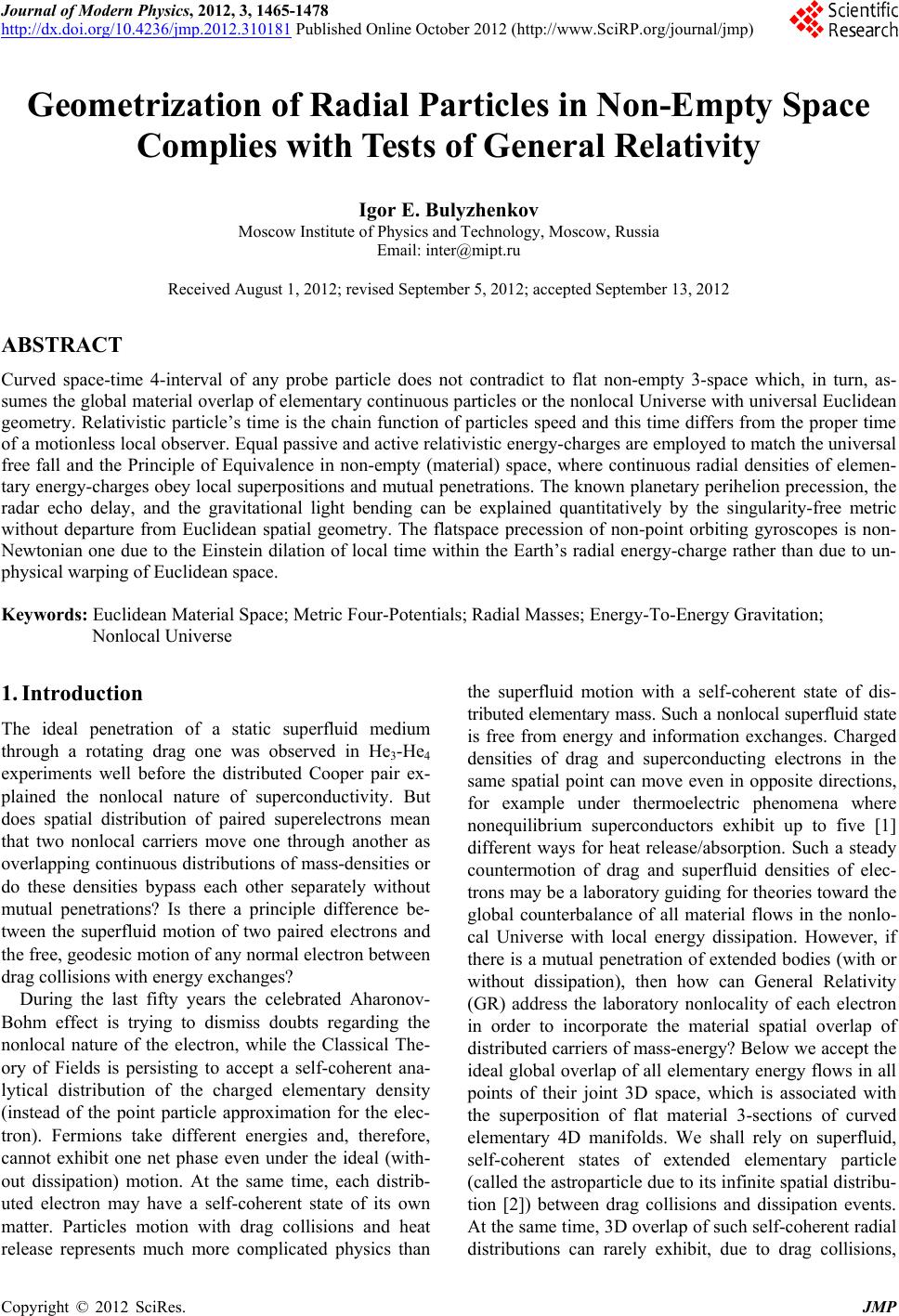 Journal of Modern Physics, 2012, 3, 1465-1478 http://dx.doi.org/10.4236/jmp.2012.310181 Published Online October 2012 (http://www.SciRP.org/journal/jmp) Geometrization of Radial Particles in Non-Empty Space Complies with Tests of General Relativity Igor E. Bulyzhenkov Moscow Institute of Physics and Technology, Moscow, Russia Email: inter@mipt.ru Received August 1, 2012; revised September 5, 2012; accepted September 13, 2012 ABSTRACT Curved space-time 4-interval of any probe particle does not contradict to flat non-empty 3-space which, in turn, as- sumes the global material overlap of elementary continuous particles or the nonlocal Universe with universal Euclidean geometry. Relativistic particle’s time is the chain function of particles speed and this time differs from the proper time of a motionless local observer. Equal passive and active relativistic energy-charges are employed to match the universal free fall and the Principle of Equivalence in non-empty (material) space, where continuous radial densities of elemen- tary energy-charges obey local superpositions and mutual penetrations. The known planetary perihelion precession, the radar echo delay, and the gravitational light bending can be explained quantitatively by the singularity-free metric without departure from Euclidean spatial geometry. The flatspace precession of non-point orbiting gyroscopes is non- Newtonian one due to the Einstein dilation of local time within the Earth’s radial energy-charge rather than due to un- physical warping of Euclidean space. Keywords: Euclidean Material Space; Metric Four-Potentials; Radial Masses; Energy-To-Energy Gravitation; Nonlocal Universe 1. Introduction The ideal penetration of a static superfluid medium through a rotating drag one was observed in He3-H e4 experiments well before the distributed Cooper pair ex- plained the nonlocal nature of superconductivity. But does spatial distribution of paired superelectrons mean that two nonlocal carriers move one through another as overlapping continuous distributions of mass-densities or do these densities bypass each other separately without mutual penetrations? Is there a principle difference be- tween the superfluid motion of two paired electrons and the free, geodesic motion of any normal electron between drag collisions with energy exchanges? During the last fifty years the celebrated Aharonov- Bohm effect is trying to dismiss doubts regarding the nonlocal nature of the electron, while the Classical The- ory of Fields is persisting to accept a self-coherent ana- lytical distribution of the charged elementary density (instead of the point particle approximation for the elec- tron). Fermions take different energies and, therefore, cannot exhibit one net phase even under the ideal (with- out dissipation) motion. At the same time, each distrib- uted electron may have a self-coherent state of its own matter. Particles motion with drag collisions and heat release represents much more complicated physics than the superfluid motion with a self-coherent state of dis- tributed elementary mass. Such a nonlocal superfluid state is free from energy and information exchanges. Charged densities of drag and superconducting electrons in the same spatial point can move even in opposite directions, for example under thermoelectric phenomena where nonequilibrium superconductors exhibit up to five [1] different ways for heat release/absorption. Such a steady countermotion of drag and superfluid densities of elec- trons may be a laboratory guiding for theories toward the global counterbalance of all material flows in the nonlo- cal Universe with local energy dissipation. However, if there is a mutual penetration of extended bodies (with or without dissipation), then how can General Relativity (GR) address the laboratory nonlocality of each electron in order to incorporate the material spatial overlap of distributed carriers of mass-energy? Below we accept the ideal global overlap of all elementary energy flows in all points of their joint 3D space, which is associated with the superposition of flat material 3-sections of curved elementary 4D manifolds. We shall rely on superfluid, self-coherent states of extended elementary particle (called the astroparticle due to its infinite spatial distribu- tion [2]) between drag collisions and dissipation events. At the same time, 3D overlap of such self-coherent radial distributions can rarely exhibit, due to drag collisions, C opyright © 2012 SciRes. JMP 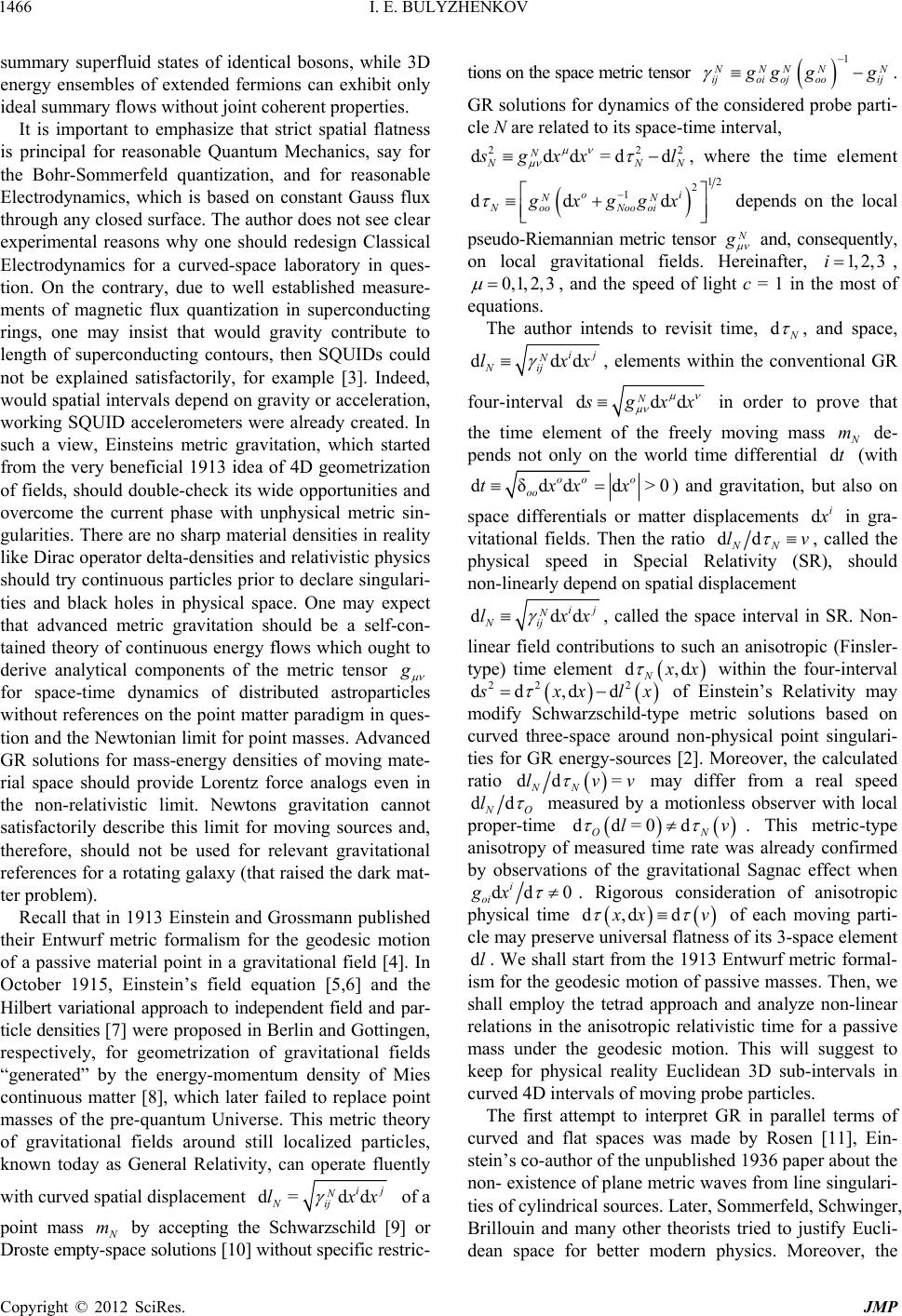 I. E. BULYZHENKOV 1466 summary superfluid states of identical bosons, while 3D energy ensembles of extended fermions can exhibit only ideal summary flows without joint coherent properties. It is important to emphasize that strict spatial flatness is principal for reasonable Quantum Mechanics, say for the Bohr-Sommerfeld quantization, and for reasonable Electrodynamics, which is based on constant Gauss flux through any closed surface. The author does not see clear experimental reasons why one should redesign Classical Electrodynamics for a curved-space laboratory in ques- tion. On the contrary, due to well established measure- ments of magnetic flux quantization in superconducting rings, one may insist that would gravity contribute to length of superconducting contours, then SQUIDs could not be explained satisfactorily, for example [3]. Indeed, would spatial intervals depend on gravity or acceleration, working SQUID accelerometers were already created. In such a view, Einsteins metric gravitation, which started from the very beneficial 1913 idea of 4D geometrization of fields, should double-check its wide opportunities and overcome the current phase with unphysical metric sin- gularities. There are no sharp material densities in reality like Dirac operator delta-densities and relativistic physics should try continuous particles prior to declare singulari- ties and black holes in physical space. One may expect that advanced metric gravitation should be a self-con- tained theory of continuous energy flows which ought to derive analytical components of the metric tensor for space-time dynamics of distributed astroparticles without references on the point matter paradigm in ques- tion and the Newtonian limit for point masses. Advanced GR solutions for mass-energy densities of moving mate- rial space should provide Lorentz force analogs even in the non-relativistic limit. Newtons gravitation cannot satisfactorily describe this limit for moving sources and, therefore, should not be used for relevant gravitational references for a rotating galaxy (that raised the dark mat- ter problem). Recall that in 1913 Einstein and Grossmann published their Entwurf metric formalism for the geodesic motion of a passive material point in a gravitational field [4]. In October 1915, Einstein’s field equation [5,6] and the Hilbert variational approach to independent field and par- ticle densities [7] were proposed in Berlin and Gottingen, respectively, for geometrization of gravitational fields “generated” by the energy-momentum density of Mies continuous matter [8], which later failed to replace point masses of the pre-quantum Universe. This metric theory of gravitational fields around still localized particles, known today as General Relativity, can operate fluently with curved spatial displacement d= dd ij N Nij lxx of a point mass m 1 by accepting the Schwarzschild [9] or Droste empty-space solutions [10] without specific restric- tions on the space metric tensor NN NN ijoi ojooij gg g 222 ddd=dd N . GR solutions for dynamics of the considered probe parti- cle N are related to its space-time interval, NN gxx l , where the time element 12 2 1 dd d oi NN NooNoo oi gxggx N depends on the local pseudo-Riemannian metric tensor and, consequently, on local gravitational fields. Hereinafter, 1, 2,3i , 0,1,2,3 , and the speed of light c = 1 in the most of equations. The author intends to revisit time, d , and space, ddd ij N Nij lxx , elements within the conventional GR four-interval ddd N gxx in order to prove that the time element of the freely moving mass m dt de- pends not only on the world time differential (with dδddd >0 oo o oo txxx di ) and gravitation, but also on space differentials or matter displacements in gra- vitational fields. Then the ratio ddlv NN , called the physical speed in Special Relativity (SR), should non-linearly depend on spatial displacement ddd ij N Nij lxx , called the space interval in SR. Non- linear field contributions to such an anisotropic (Finsler- type) time element d,d N x within the four-interval 22 2 dd ,dd xxl x of Einstein’s Relativity may modify Schwarzschild-type metric solutions based on curved three-space around non-physical point singulari- ties for GR energy-sources [2]. Moreover, the calculated ratio dd = NN lvv may differ from a real speed ddl O measured by a motionless observer with local proper-time dd=0dlv ON . This metric-type anisotropy of measured time rate was already confirmed by observations of the gravitational Sagnac effect when dd 0 i gx oi . Rigorous consideration of anisotropic physical time d,d d xv dl of each moving parti- cle may preserve universal flatness of its 3-space element . We shall start from the 1913 Entwurf metric formal- ism for the geodesic motion of passive masses. Then, we shall employ the tetrad approach and analyze non-linear relations in the anisotropic relativistic time for a passive mass under the geodesic motion. This will suggest to keep for physical reality Euclidean 3D sub-intervals in curved 4D intervals of moving probe particles. The first attempt to interpret GR in parallel terms of curved and flat spaces was made by Rosen [11], Ein- stein’s co-author of the unpublished 1936 paper about the non- existence of plane metric waves from line singulari- ties of cylindrical sources. Later, Sommerfeld, Schwinger, Brillouin and many other theorists tried to justify Eucli- dean space for better modern physics. Moreover, the Copyright © 2012 SciRes. JMP 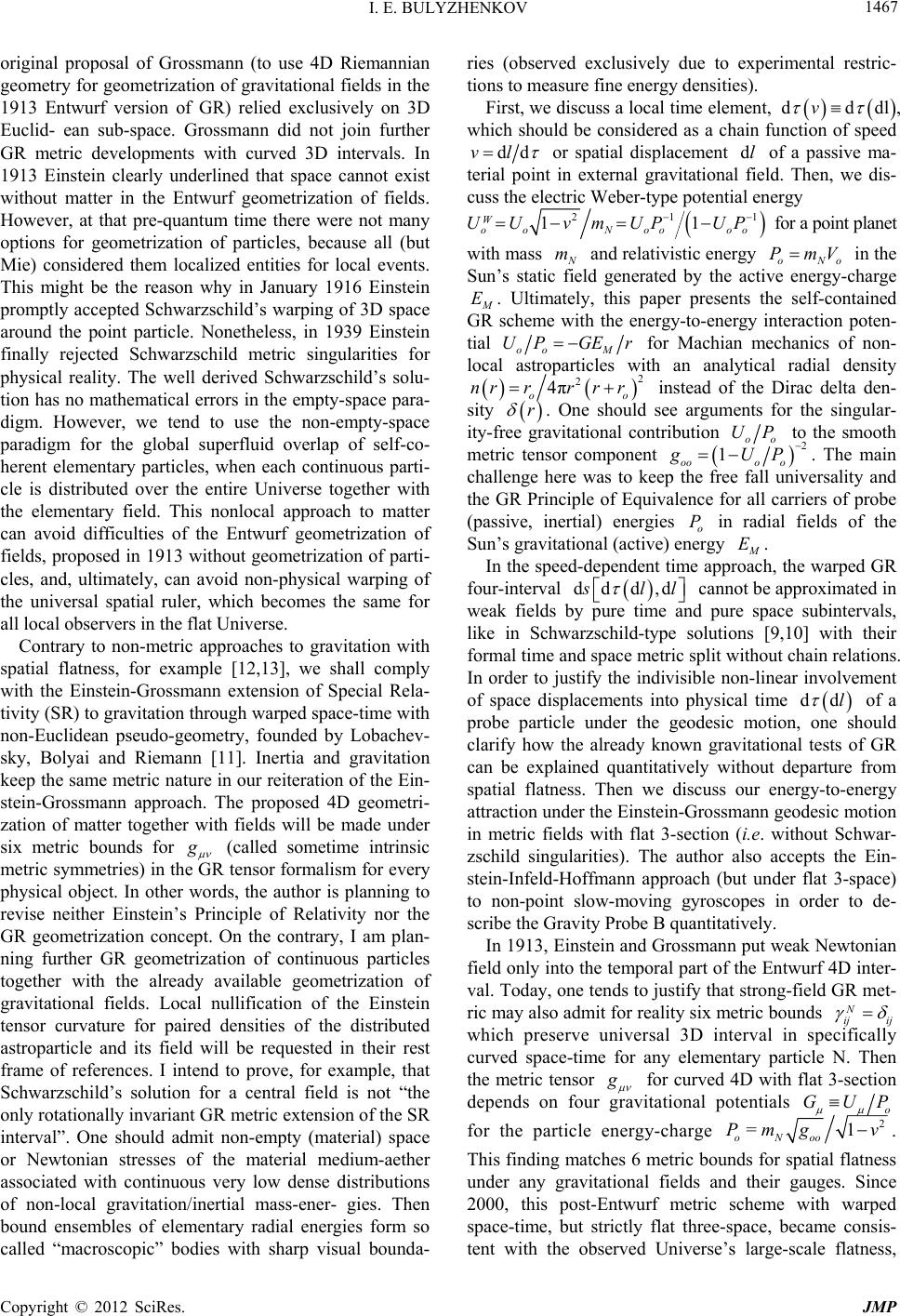 I. E. BULYZHENKOV 1467 original proposal of Grossmann (to use 4D Riemannian geometry for geometrization of gravitational fields in the 1913 Entwurf version of GR) relied exclusively on 3D Euclid- ean sub-space. Grossmann did not join further GR metric developments with curved 3D intervals. In 1913 Einstein clearly underlined that space cannot exist without matter in the Entwurf geometrization of fields. However, at that pre-quantum time there were not many options for geometrization of particles, because all (but Mie) considered them localized entities for local events. This might be the reason why in January 1916 Einstein promptly accepted Schwarzschild’s warping of 3D space around the point particle. Nonetheless, in 1939 Einstein finally rejected Schwarzschild metric singularities for physical reality. The well derived Schwarzschild’s solu- tion has no mathematical errors in the empty-space para- digm. However, we tend to use the non-empty-space paradigm for the global superfluid overlap of self-co- herent elementary particles, when each continuous parti- cle is distributed over the entire Universe together with the elementary field. This nonlocal approach to matter can avoid difficulties of the Entwurf geometrization of fields, proposed in 1913 without geometrization of parti- cles, and, ultimately, can avoid non-physical warping of the universal spatial ruler, which becomes the same for all local observers in the flat Universe. Contrary to non-metric approaches to gravitation with spatial flatness, for example [12,13], we shall comply with the Einstein-Grossmann extension of Special Rela- tivity (SR) to gravitation through warped space-time with non-Euclidean pseudo-geometry, founded by Lobachev- sky, Bolyai and Riemann [11]. Inertia and gravitation keep the same metric nature in our reiteration of the Ein- stein-Grossmann approach. The proposed 4D geometri- zation of matter together with fields will be made under six metric bounds for (called sometime intrinsic metric symmetries) in the GR tensor formalism for every physical object. In other words, the author is planning to revise neither Einstein’s Principle of Relativity nor the GR geometrization concept. On the contrary, I am plan- ning further GR geometrization of continuous particles together with the already available geometrization of gravitational fields. Local nullification of the Einstein tensor curvature for paired densities of the distributed astroparticle and its field will be requested in their rest frame of references. I intend to prove, for example, that Schwarzschild’s solution for a central field is not “the only rotationally invariant GR metric extension of the SR interval”. One should admit non-empty (material) space or Newtonian stresses of the material medium-aether associated with continuous very low dense distributions of non-local gravitation/inertial mass-ener- gies. Then bound ensembles of elementary radial energies form so called “macroscopic” bodies with sharp visual bounda- ries (observed exclusively due to experimental restric- tions to measure fine energy densities). First, we discuss a local time element, dddlv , which should be considered as a chain function of speed ddvl or spatial displacement of a passive ma- terial point in external gravitational field. Then, we dis- cuss the electric Weber-type potential energy dl 211 11 W ooNoooo UU vmUPUP for a point planet with mass mPmV and relativistic energy oNo in the Sun’s static field generated by the active energy-charge E. Ultimately, this paper presents the self-contained GR scheme with the energy-to-energy interaction poten- tial oo M UPGE r for Machian mechanics of non- local astroparticles with an analytical radial density 2 2 4π o nrrrr r o instead of the Dirac delta den- sity r . One should see arguments for the singular- ity-free gravitational contribution oo UP to the smooth metric tensor component 2 1gUP P ooo o. The main challenge here was to keep the free fall universality and the GR Principle of Equivalence for all carriers of probe (passive, inertial) energies o in radial fields of the Sun’s gravitational (active) energy E . In the speed-dependent time approach, the warped GR four-interval ddd,d ll cannot be approximated in weak fields by pure time and pure space subintervals, like in Schwarzschild-type solutions [9,10] with their formal time and space metric split without chain relations. In order to justify the indivisible non-linear involvement of space displacements into physical time ddl N of a probe particle under the geodesic motion, one should clarify how the already known gravitational tests of GR can be explained quantitatively without departure from spatial flatness. Then we discuss our energy-to-energy attraction under the Einstein-Grossmann geodesic motion in metric fields with flat 3-section (i.e. without Schwar- zschild singularities). The author also accepts the Ein- stein-Infeld-Hoffmann approach (but under flat 3-space) to non-point slow-moving gyroscopes in order to de- scribe the Gravity Probe B quantitatively. In 1913, Einstein and Grossmann put weak Newtonian field only into the temporal part of the Entwurf 4D inter- val. Today, one tends to justify that strong-field GR met- ric may also admit for reality six metric bounds ijij which preserve universal 3D interval in specifically curved space-time for any elementary particle N. Then the metric tensor for curved 4D with flat 3-section depends on four gravitational potentials o GUP 2 =1 oNoo Pmg v for the particle energy-charge . This finding matches 6 metric bounds for spatial flatness under any gravitational fields and their gauges. Since 2000, this post-Entwurf metric scheme with warped space-time, but strictly flat three-space, became consis- tent with the observed Universe’s large-scale flatness, Copyright © 2012 SciRes. JMP 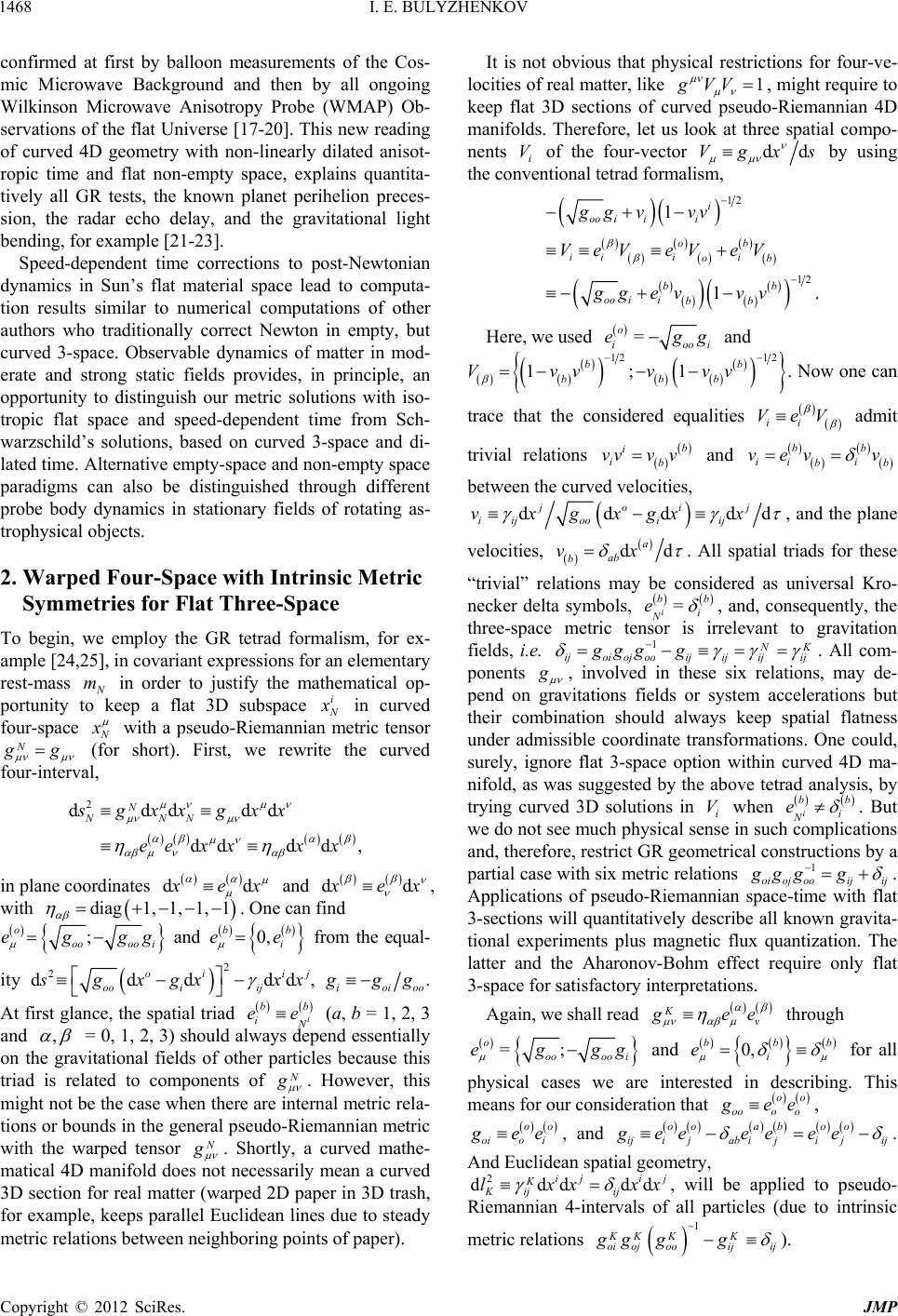 I. E. BULYZHENKOV 1468 confirmed at first by balloon measurements of the Cos- mic Microwave Background and then by all ongoing Wilkinson Microwave Anisotropy Probe (WMAP) Ob- servations of the flat Universe [17-20]. This new reading of curved 4D geometry with non-linearly dilated anisot- ropic time and flat non-empty space, explains quantita- tively all GR tests, the known planet perihelion preces- sion, the radar echo delay, and the gravitational light bending, for example [21-23]. Speed-dependent time corrections to post-Newtonian dynamics in Sun’s flat material space lead to computa- tion results similar to numerical computations of other authors who traditionally correct Newton in empty, but curved 3-space. Observable dynamics of matter in mod- erate and strong static fields provides, in principle, an opportunity to distinguish our metric solutions with iso- tropic flat space and speed-dependent time from Sch- warzschild’s solutions, based on curved 3-space and di- lated time. Alternative empty-space and non-empty space paradigms can also be distinguished through different probe body dynamics in stationary fields of rotating as- trophysical objects. 2. Warped Four-Space with Intrinsic Metric Symmetries for Flat Three-Space To begin, we employ the GR tetrad formalism, for ex- ample [24,25], in covariant expressions for an elementary rest-mass mi in order to justify the mathematical op- portunity to keep a flat 3D subspace in curved four-space with a pseudo-Riemannian metric tensor N g (for short). First, we rewrite the curved four-interval, dd d d, xx x x 2 ddd dd N NNN sgxxg ee xx in plane coordinates dd ex d and d ex , g1,1, 1, d with 1. One can findia o eg bb ; oo oo i gg and 0, i ee from the equal- ity 2 dd i ij 2 dd d oi oo ij gxgxxx , ioioo gg . irst glance, thad i i At f e spatial tri bb ee(a, b = 1, 2, 3 and , = 0, 1, 2, 3) should apend essentially on thvitational fields of other particles because this triad is related to components of lways de e gra . However, this might not be the case when there are ernal metric rela- tions or bounds in the general pseudo-Riemannian metric with the warped tensor int . Shortly, a curved mathe- matical 4D manifold does necessarily mean a curved 3D section for real matter (warped 2D paper in 3D trash, for example, keeps parallel Euclidean lines due to steady metric relations between neighboring points of paper). It is not obvious that physical restrictions for four-v not e- lo rved pseud cities of real matter, like 1gVV , might require to keep flat 3D sections of cuo-Riemannian 4D manifolds. Therefore, let us look at three spatial compo- nents i V of the four-vector ddVgxs by using the conventional tetrad formalism, 12 1i gg vvv 12 1. oo i ii ob iii i ob bb oo iibb Ve VeV eV gg evvv Here, we used = o iooi egg and 12 1 bb b Vv vv . Now one can trace that the considered equalities ii VeV 12 1; bb v v admit trivial relations ib vvvv and bb ii i bb vevv d velocities, b i between the curve ddd joi iij ooi vxgxgxdd j ij x , and the plane velocities, dd a ab b vx . All spatial triads for t ations may be c N hese “trivial” relonsidered as universal Kro- necker delta symbols, = i bb i e , and, consequently, the three-space metric tenrelevant to gravitation fields, i.e. 1N sor is ir ijoi oj ooijijijij ggg g . All com- ponents , involved in these six relations gra N , may de- pend on vitations fields or system accelerations but their combination should always keep spatial flatness under admissible coordinate transformations. One could, surely, ignore flat 3-space option within curved 4D ma- nifold, as was suggested by the above tetrad analysis, by trying curved 3D solutions in i V when i bb i e . But we do not see much physical sense in suchtions and, therefore, restrict GR geometrical constructions by a partial case with six metric relations 1 oi oj ooijij ggg g complica . Applications of pseudo-Riemannian t 3-sections will quantitatively describe all known gravita- tional experiments plus magnetic flux quantization. The latter and the Aharonov-Bohm effect require only flat 3-space for satisfactory interpretations. Again, we shall read Kv space-time with fla ee through =; oggg and bb oooo i e 0, b i e for all physical cases we arested in describine interg. This means for our consideration that oo ooo o ee, oo oio i ee, and oo o ij ijij gee e ab o abij ij ee e . And Euclidean spatial geometry, e applied to pseudo- Riemannian 4-intervals of 2 ddddd ij ij K Kijij lxxxx , will b all particles (due to intrinsic metric relations 1 KK KK oi ojooijij gg gg ). Copyright © 2012 SciRes. JMP 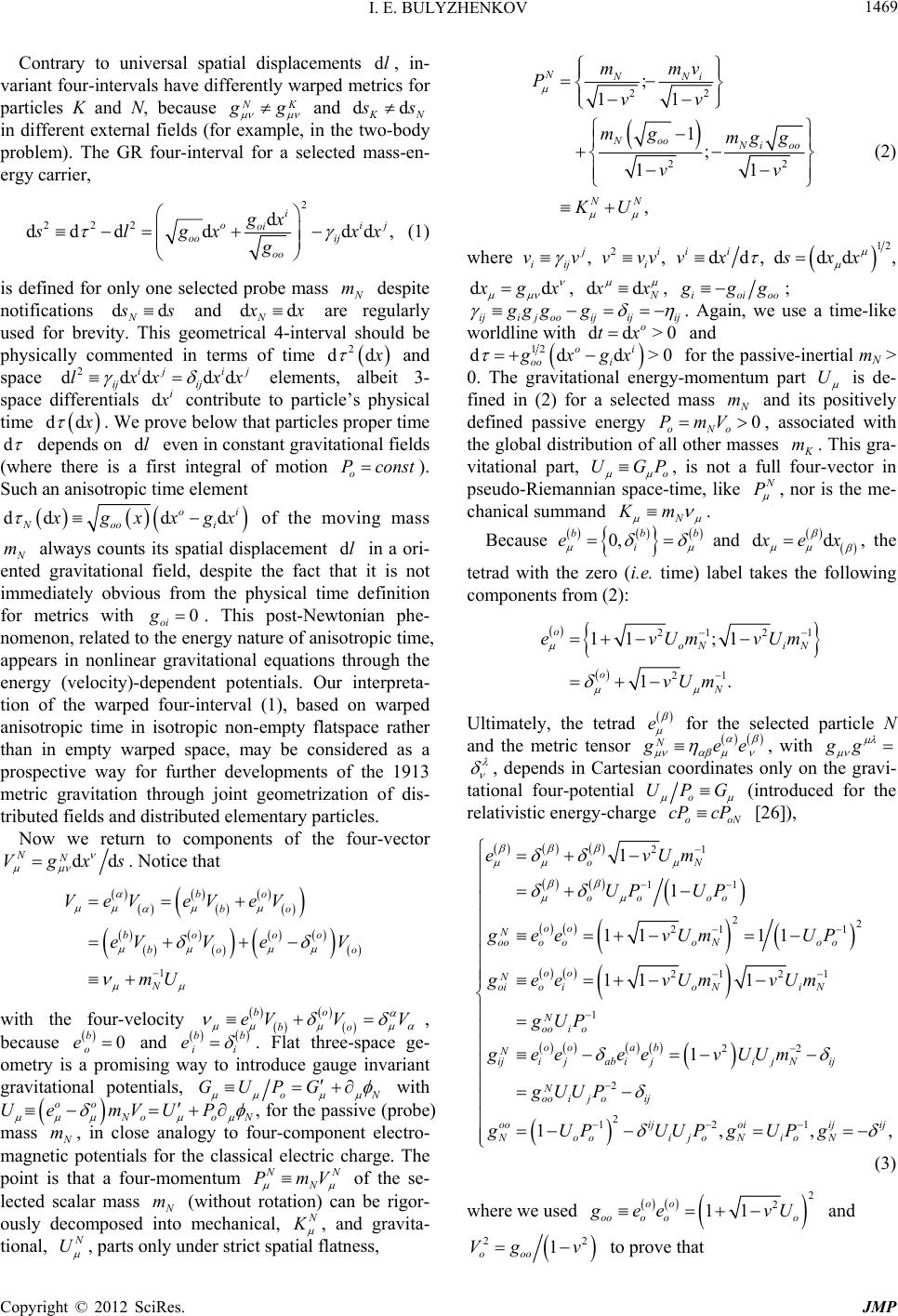 I. E. BULYZHENKOV 1469 Contrary to univeements variant four-interpe rsal spatial acdl, in- vals have differen ward metrics for pa displ tly rticles K and N, because N g and dd N s in different external fields (for example, in the two-body problem). The GR four-intervelected ergy carrier, al for a s mass-en- 2 22 dd 2d d ddd, i oij oi oo ij oo gx lgxxx g (1) is defined for only one selectedobe mass pr m despite notifications dd N s and dd N x are regularly l s m e used for brevity. This geometrical 4-intervahould be physically co mented in terms of tim 2 dd and space 2 ddddd ij ij ij ij lxxxx elements, albeit 3- space differentials di contribute to particsical time le’s phy dd . We prove below that particles proper time d depends on dlen in constant gravitational fields (wher is a first integral of motion o Pconst ev e there ). h an anisotropic time element Suc ddd d oi Noo i gx xgx of the moving mss a m always counts its spatial ented gravitational field, des imm e definition r gravi dis pite placement dl in a ori- the fact that it is not ediately obvious from the physical tim for metrics with 0 oi g. This post-Newtonian phe- nomenon, related to the energy nature of anisotropic time, appears in nonlineatational equations through the energy (velocity)-dependent potentials. Our interpreta- tion of the warped four-interval (1), based on warped anisotropic time in isotropic non-empty flatspace rather than in empty warped space, may be considered as a prospective way for further developments of the 1913 metric gravitation through joint geometrization of dis- tributed fields and distributed elementary particles. Now we return to components of the four-vector dd NN Vgxs . Notice that bo b V eV 1 o bo oo bo o N Ve eV eVV eV mU with the bo bo V V four-velocity eV 0 and bb i e 22 ; 11 NNNi mmv vv 22 1; 11 , No oNioo NN P mg mg g vv KU (2) where , because b eoi . Flat t to introduce l pot hree-space ge- gauge invarianometry is a promising wayt gravitatio entials,naoN PG GU with oo ooN Ue mVUP , for the passive (probe) mass m, in close analoglectro- al electric charge. The point is that a four-momentum y to four-c tials for the classic omponent e magnetic poten N N PmV of the se- lected scalar mass m (without rotation) can be rigor- ously decomposed into mechanical, , and gravita- tional, U , parts onunder strict spatial flatness, ly iij vv , 2i i vvv, dd ii vx , 12 dddsxx , dd gx , dd x , ioioo gg ; j ooijij ggg ij iij g . Again, we use a time-lik worldline witdd> o tx and e h 0 12 ddd>0 i oo i gxgx onal energy ofor the passive-inertial mN > 0. The gravitati-momentum part U is de- fined in (2) for a selected mass m and its positively defined passive energy 0 oNo PmV, associated with the global distribution of all other sses ma m. This gra- vitational part, UGP o , is not a full four-vector in pseudo-Riemannian space-time, like P , r is the me- chanical summanN no d Km . Because 0, bbb i e and dd ex , the tetrad with the zeo r (i.e. time) label takes the following corom (2): mponents f 21 21 11 ;1 o evUmvUm 21 1. oN iN oN vUm Ultimately, the tetrad e for the selected particle N and the metric tensor N ee , with gg , depends in Cartesiaoordinates only on the gravi- tational four-potential n c o UPG (ind for t e e troduceh rlativistic energy-charge ooN cP cP [26]), 1 11 22 21 1 21 21 1 22 2 2 1 1 11 11 11 1 1 1 oo oo oo N oooooNo o oo N oioio Ni N N ooi o oo ab N ijijab ijijNij N ooij oij oo ij Noo i m UP UP geevUm UP geevUm vUm gUP gee eevUUm gUUP gUPUU 21 ,,, oiij ij jo NioN Pg UPg 2 1 oN evU (3) where we used 2 2 11 oo ooo oo gee vU and 22 1 ooo Vg v to prove that Copyright © 2012 SciRes. JMP 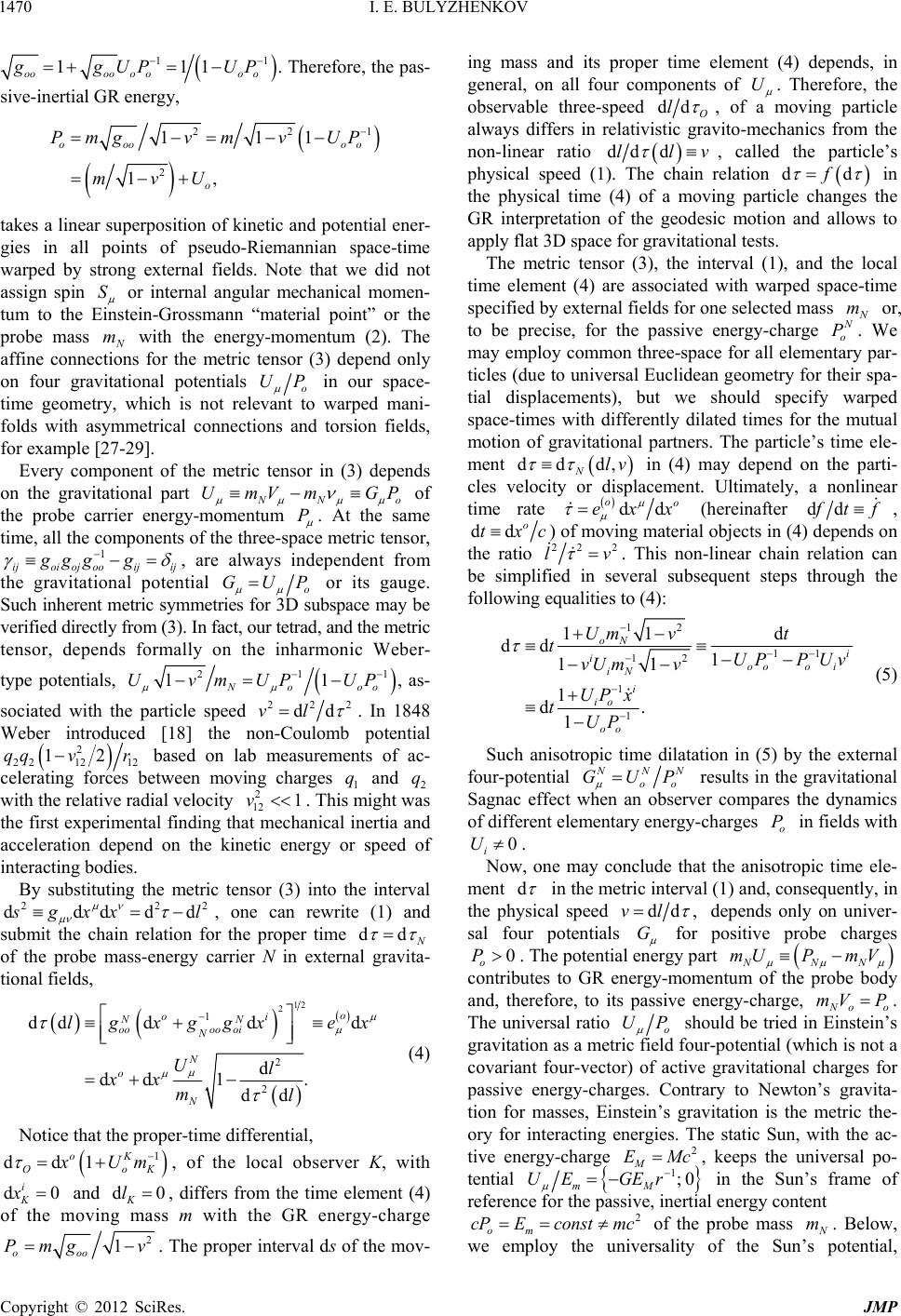 I. E. BULYZHENKOV 1470 11 11 o oo o 1 oo oo gU e, the paP UP . Therefors- sive-inertial GR energy, 21 2 1 1 oo v UP mvU 2 11 , ooo o Pmgv m takes a linear superposition of kinetic and potential ener- gies in all points of pseudo-Riemannian space-time warped by strong external fields. Note that we did not assign spin S or internal angular mechanical momen- tum to the Einstein-Grossmann “material point” or the probe mass m with the energy-momentum (2). The affine connecions for the metric tensor (3) depend only on four gravitational potentials t o UP in our space- time geometr which is not relevant to warped mani- folds with asymmetrical connections and torsion fields, for example [27-29]. Every component of the metric tensor in (3) depends on the gravitational part y, No UmVm GP of the probe carrier energy-momentum P . At the same time, all the components of the three-space metric tensor, 1 ijoi oj ooijij ggg g , aom the gravitational potential re always independent fr o from (3 the inhar GUP or its gauge. Such inherent metric symmetries for 3D subspace may be verified directly). In fact, our tetrad, and the metric tensor, depends formally onmonic Weber- type potentials, 211 11 No oo UvmUP UP , as- sociated with the particle speed 222 ddvl . In 1848 Weber introduced [18] the non-Coulomb potential 2 2 212 12qq vr ac- 12 easurements of ch q perime of based on lab m celerating forces between movin1 and 2 q with the relative radial velocity 2 12 1v . This might was the first extal finding that mechanical inertia and acceleration depend on the kinetic energy or speed interacting bodies. By substituting the metric tensor (3) into the interval 222 ddddd g arges n gxx l , one can rewrite (1) and submit the chain relation for the proper time dd of the probe mass-energy carrier N in external gravita- tional fields, 12 2 1 dd ddd o oi NN oooooi N lgxggxex 2 2 d dd 1 . dd N o N Ul xx ml (4) Notice that the proper-time differential, 1 1 oK OoK xUm , of the local observer K, with e element (4) ergy-charge dd i d0x of K and d0 K l, differs from the tim the moving mass m with the GR en 2 1 ooo g v. ing masits pro Pm The proper interval ds of the mov- s and per time element (4) depends, in general, on all four components of U . Therefore, the observable three-speed dd O l , of a moving particle always differs in relativistic gravito-mechanics from the non-linear ratio dd dllv , called the particle’s physical speed (1). The chain relation ddf in the physical time (4) of a moving particle changes the GR interpretation of the geodesic motion and allows to apply flat 3D space for gravitational tests. The metric tensor (3), the interval (1), and the local time element (4) are associated with warped space-time specified by external fields for one selected mass m or, to be precise, for the passive energy-charge o P. We may employ common three-space for all elementary par- ticles (due to universal Euclidean geometry for their spa- tial displacements), but we should specify arped space-times with differently dilated times for the mutual motion of gravitational partners. The particle’s time ele- ment w ddd, Nlv in (4) may depend on the parti- cles velocity or displacement. Ultimately, a nonlinear time rate dd oo exx (hereinafter dd tf , dd o txc) of moving material objects in (4) depends on the ratio 22 2 lv . This non-linear chain relation can be simplified in several subsequent steps through the following equalities to (4): 12 11 12 1 1d dd 1 11 1 Ni ioo oi iN i vt tUP PUv vUm v UP x 1 1 d. 1 o io oo Um tUP (5) Such anisotropic time dilatation in (5) by the ex four-potential ternal NN oo GUP results in the gravitational Sagnac effect when an observer compares the dynamics of different elementary energy-charges o P in fields with 0 i U . Now, one may conclude that the anisotropic time ele- ment d in the metric interval (1) and, consequently, in the physical speed dd,vl depends only on univer- ur sal fopotentials G for positive probe charges 0 o P. The potential energy part NNN mUP mV contributes to GR energy-momentum of the probe body and, therefore, to its passive energy-charge, oo mV P . The universal ratio o UP should be tried gravitation as a metric field four-potential (which is not a covariant four-vector) of active gravitational charges for passive energy-charges. Contrary to Newton’s gravita- tion for masses, Einstein’s gravitation is the metric the- ory for interacting energies. The static Sun, with the ac- tive energy-charge 2 M EMc, keeps the universal po- tential in Einstein’s 1;0 mM UE GEr in the Sun’s frame of reference for the passive, inertial energy content 2 om cPEconst mc of the probe mass m. Below, we employ the unof the Sun’s potential, iversality Copyright © 2012 SciRes. JMP 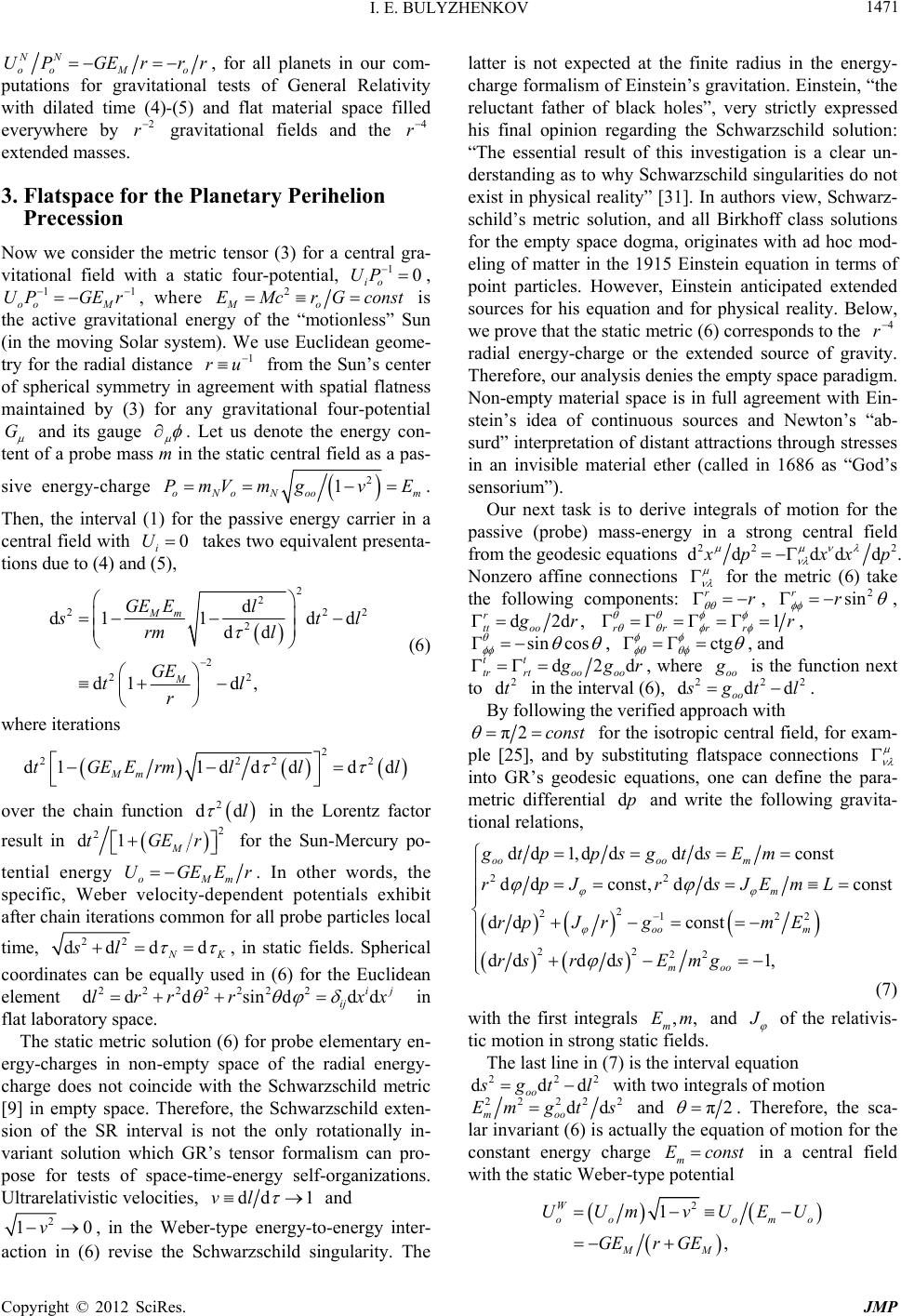 I. E. BULYZHENKOV 1471 NN ooMo UP r all planets in our com- putations for gravitational tests of General Re (5) and flat material spce filled everywhere by 2 r gravitational fields and the 4 r GEr rr , fo lativity with dilated time (4)-a 3. Flatspace for the Planetary Perihelion Precession Now we consider extended masses. the metric tensor (3) a central gra- 0 for vitational field with a static four-potential, 1 io UP , 11 oo M UPGE r , where 2 EMcrGcons active gravitaMo of the “mo ment with sp t is tionless” Sun n’s cente ricalatial flatn th of e sphe tional energy ymm (in the moving Solar system). We use Euclidean geome- try for the radial distance 1 ru from the Sur etry in agreeess maintained by (3) for any gravitational four-potential G s and its gauge . Let us denote the energy con- tent of a probe mass m in tc central field as a pas- sive energy-charge he stati 2 1 oNoNoo m PmVmgv E . n, the interval (1) for the passive energy carrier in a central field with 0 i U takes two equivalent presenta- The ), tions due to (4) and (5 2 2 222 2 d d1 1dd dd Mm GE El 2 22 d1 d, M tl l (6) rm GE tl r where iterations 2 22 1dd dd d Mm tGEErm lll ion 22 d1 over the chain funct 2 ddl in the Lorentz factor resun lt i 2 d1 M tGEr for the Sun-Mercury po- 2 ten ergy tial enoMm UGEEr . In other words, t e -depend iterations common for all p h specific, Weber velocityent potentials exhibit after chainrobe particles local time, 22 ddd d K sl static metric solution (6 oes not coincide with the Schwarzschild me herefore, the Schwarzschild exten- si static fields. Spherical coordinates can be equally used in (6) for the Euclidean element 2222222 dd dsinddd ij ij lrrrxx in flat laboratory space. , in The) for probe elementary en- ergy-charges in non-empty space of the radial energy- charge dtric [9] in empty space. T on of the SR interval is not the only rotationally in- variant solution which GR’s tensor formalism can pro- pose for tests of space-time-energy self-organizations. Ultrarelativistic velocities, dd1vl and 2 10v, in the Weber-type energy-to-energy inter- action in (6) revise the Schwarzschild singularity. The latter is not expected at the finite radius in the energy- charge formalism of Einstein. Einste n’s gravitatioin, “the reluctant father of black holes”, very strictly expressed his final opinion regarding the Schwarzschild solution: “The essential result of this investigation is a clear un- derstanding as to why Schwarzschild singularities do not exist in physical reality” [31]. In authors view, Schwarz- schild’s metric solution, and all Birkhoff class solutions for the empty space dogma, originates with ad hoc mod- eling of matter in the 1915 Einstein equation in terms of point particles. However, Einstein anticipated extended sources for his equation and for physical reality. Below, we prove that the static metric (6) corresponds to the 4 r radial energy-charge or the extended source of gravity. Therefore, our analysis denies the empty space paradigm. Non-empty material space is in full agreement with Ein- stein’s idea of continuous sources and Newton’s “ surd” interpretation of distant attractions through stresses in an invisible material ether (called in 1686 as “God’s sensorium”). Our next task is to derive integrals of motion for the passive (probe) mass-energy in a strong central field from the geodesic equations ab- 22 2 dd ddd pxxp . Nonzero affine connections for the metric (6) take the following components: rr , 2 sin rr , d2d, r ttoo r ΓΓΓΓ1 rrrr r , Γsin cos , ΓΓctg , and d2d tr rtoo oo tt gr, wh ere oo is the function next 2 dt in the interval (6), 222 ddd oo to gt l. wing thpoach withBy folloe verified apr π2const for the ispic ceral field, for exam- ple [25], and by substituting flatspace connections otro nt into GR’s geodesic eq tric write the following grav uations, one can define the para- me differential dp andita- tional relations, 22 2122 2 d ddconst dd const,ddconst d dconst oooo m m oo m psgtsEm rpJrsJEmL rpJr gmE 2 2 22 dd 1,d ddd d1, mo o gtp rsrs Emg (7) with the first integrals ,, m Em and of the relativis- tic motion in strong static fields. The last line in (7) is the interval equation 222 ddd oo gt l with two integrals of motion 22222 dd moo Em gt s and π2 . Therefore, the lly the n in sca- lar invariant (6) is actuaequatio of motion for the constant energy charge m Econst a central field with the static Weber-type potential 2 1 , omo MM m vUEU GErGE W oo UU Copyright © 2012 SciRes. JMP 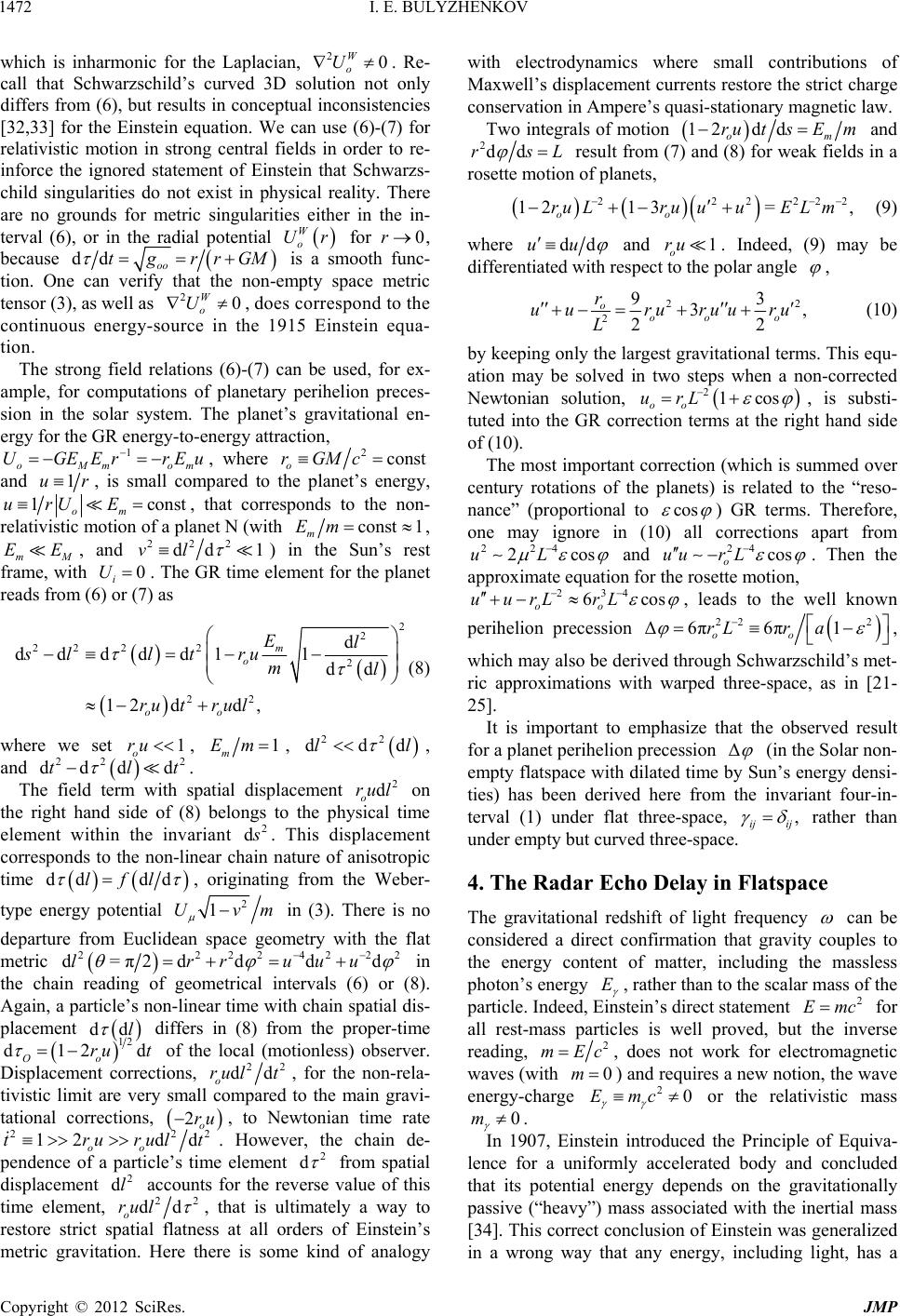 I. E. BULYZHENKOV 1472 which is inharmonic for t 20 W o U. Re- call that Schwarzschild’s curved 3D he Laplacian, solution not only differs from (6), but results in conceptual inconsistencies [32,33] for the Einstein equation. We can use (6)-(7) for relativistic motion in strong central fields in order to re- inforce the ignored statement of Einstein that Schwarzs- l reality. child singularities do not exist in physicaThere are no grounds for metric singularities either in the in- terval (6), or in the radial potential W o Ur for 0r, because dd oo tgrrGM is a smooth func- tion. One can verify that the non-empty space metric tensor (3), as well as 20 W o U, does correspond to the continuous energy-source in the 1915 Einstein equa- tion. The strong field relations (6)-(7) can be used, for ex- ample, for computations of planetary perihelion preces- sion in the solar system. The planet’s gravitational en- ergy for the GR energy-to-energy attraction, 1 oMmom UGEEr rEu , where 2const o rGMc and 1ur, is small compared to the planet’s energy, 1const om urU E, that corresponds to the non- relativistic motion of a planet N (with const1 m Em, mM EE, and 222 dd 1vl ) in the Sun’s rest frame, with 0U. The Gement for i s from (6) or (7) as R time elt read the plane 1 12r 2 2 22 22 2 22 d ddddd1 dd d d, m o oo El sllt ru ml utru l (8) where we set 1 o ru , 1 m Em, 22 dddll , 2 dt . with spatial displacement 2 d o rul the right hand side of (8) belothe physical time element withinvariant and dd The 22 dtl field term on ngs to 2 d the in . Th u is displacement n-lire of anisotropiccorresponds to the near chain nat time no ddlddlf origiom the Weber , - ty nating fr pe energy potential 2 1Uvm in (3). Ths no departure from Euclidean space geometry with the flat metric ere i 22 224222 d=π2d dddlrruuu in the chain reading of geometrical intervals (6) or (8). Againnear time with chain spatial dis-, a particle’s non-li placement ddl differom the proper-time rs in (8) f 12 d12 d Oo ru t of the local (motionless) observer. Displacement corrections, 22 ddrult, for the non-rela- tivistic limit are very small compared to the main gravi- tational corrections, 2o ru, to Newtonian time rate o 222 12 dd o trurult . However, the chain de- pendence of a icle’s time element 2 d o part from spatial displacement dl accounts for the reverse value of this time element, 2 22 dd o rul , that is ultimately a way to restore strict spatial flatness at all orders of Einstein’s metric gravitation. Hee is some kind of analogy re small contributions of Maxwell’s displacement currents restore strict charge conservation in Ampere’s quasi-stationary magnetic law. Two integrals re ther with electrodynamics whe e th of motion12 dd om ru t sE m and 2ddrsL result from (7) and (8) for weak fields in a rosette motion of planets, 222222 1213=, oo ruLruuuE Lm (9) where dduu and 1ru . Indeed, (9) may be o fferentiated with respect todi the polar angle , 2 2 93 oo r u uru2 3, 22 oo ru uru L (10) by keeping only the largest gravitational terms. Thi ay be solveo step s equ- ation md in tws when a non-corrected Newtonian solution, 21cos oo urL , is substi- tuted into the GR correction terms at the right hand side of (10). The most important correction (which is summed over century rotations of the planets) is related to the “reso- nance” (proportional to cos ) GR terms. Therefore, one may ignore in apart from 224 2cosuL (10) all corrections and 24 cos o uu rL . Then the approximate equation for the rosette motion, u234 6cos oo urLrL , leads to the well known perihelion precession 222 Δ6π6π1 oo rLr a , which may also be derived through Schwarzschild’s met- ric with w, as in [21- 25]. approximations arped three-space It is important to empha reces size that the observed result sion Δ for a planet perihelion p (in the Solar non ated time by Sun’s energy densi - empty flatspace with dil- ties) has been derived here from the invariant four-in- terval (1) under flat three-space, , ij ij rather than under empty but curved three-space. 4. The Radar Echo Delay in Flatspace The gravitational redshift of light frequency can be considered a direct confirmation that gravity couples to the energy content of matter, includithe massless photon’s energy Eng , rather than to the scalar mass of the 2 c for inverse particle. Indeed, Einstein’s direct statement Em all rest-mass particles is well proved, but the reading, 2 mEc, does not work for electromagnetic waves (with 0m ) and requires a new notion, the wave energy-charge 20Emc or the relativistic mass 0 m . In 1907, Einstein introduced the Principle of Eq lence for a uniformly accelerated body and concluded that its potential energy depends on the gravitationally passive (“heavy”) mass associated with the inertial mass [34]. This correct concluf Einstein was generalized ron uiva- sion o in a wg way that any energy, including light, has a Copyright © 2012 SciRes. JMP 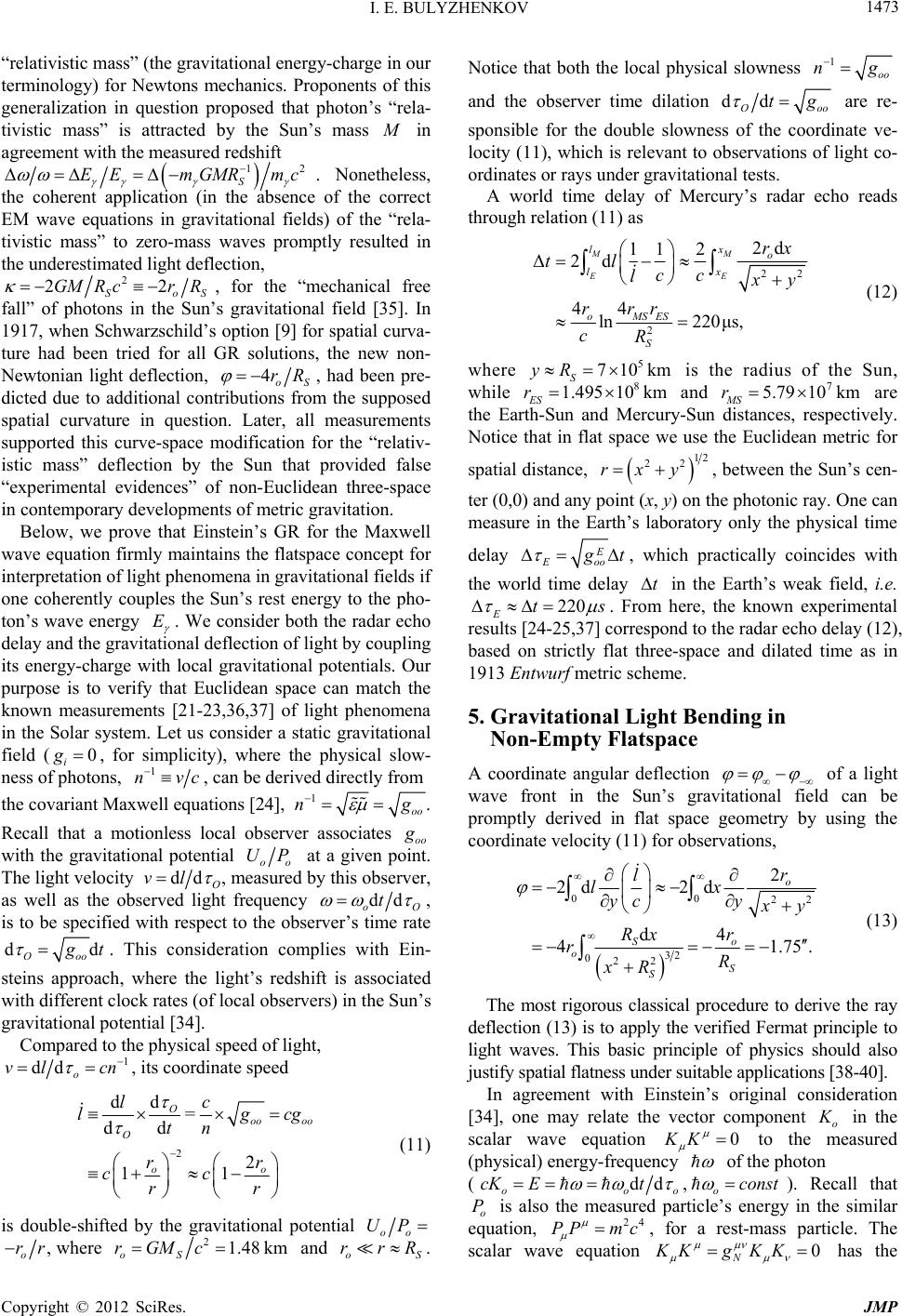 I. E. BULYZHENKOV 1473 “relativistic mass” (the gravitational energy-charge in our terminology) for Newtons mechanics. Proponents of this generalization in question proposed that photon’s “rela- tivistic mass” is attracted by the Sun’s mass in agreement with the measured redshift 12 S EEmGMR mc . Nonetheless, the coherent application (in the absence of the correct EM wave equations in gravitational fields) of the “rela- tivistic mass” to zero-mass waves promptly resulted in the underestimated light deflection, 2 22 S GMR crR , for the al field [35]. In 1917, when Schwarzschild’s option [9] for spatial curva- ture had been tried for all GR solutions, the new non- Newtonian light deflection, oS “mechanical free fall” of photons in the Sun’s gravitation 4oS rR , had been pre- dicted due to additional contributions on. Later, all measurements supported this curve-space modification for the “relativ- istic mass” deflection by the Sun that provided false “experimental evidences” of non-Euclidean three-space in contemporary developmenravitation. Below, we prove that Einstein’s GR for the Maxwell wave equation firmly maintains the flatspace concept for interpretation of light phenomena in gravitational fields if one coherently couples the Sun’s rest energy to the pho- ton’s wave energy E from the supposed spatial curvature in questi ts of metric g . We consider both the radar echo delay and the gravitational deflection of light by coupling its imp energy-charge with local gravitational potentials. Our purpose is to verify that Euclidean space can match the known measurements [21-23,36,37] of light phenomena in the Solar system. Let us consider a static gravitational field (0 i g, for slicity), where the physical slow- ness of photons, 1 nvc , can be derived directly from the covariant Maxwell equations [24], 1oo ng . Recall that a motionless local observer associates oo with the gravitational potential oo UP at a given point. The light velocity dd O vl , measured by this observer, as well as the observed light frequency dd oO t , is to be specified with respect to the observer’s time rate dd Ooo t . This consideration complies with Ein- steins approach, where the light’s redshift is associa with different clock rates (of local observers) in the Sun’s gravitational potential [34]. Compared to the physical speed of light, ted 1 dd o vl cn , its coordinate speed 2 dd 2 1 oo oo O oo tn rr cc d d= O lc gcg 1 l rr (11) is double-shiftedtial by the gravitational potenoo UP o rr, where 2 oS rGMc oS rrR 1.48km and . Notice that both the local physical slowness 1oo ng and the observer time dilation dd O t sponsible for the double slowness of the coordinate ve- locity (11), which is relevant to observations of light co- ho reads through relation (11) as oo g are re- ordinates or rays under gravitational tests. A world time delay of Mercury’s radar ec 22 o 2 44 ln 220μs, oM SES S 2d 11 2 Δ2d MM EE lx lx rx tl cc l y and 7 5.7910 km MS r are the Earth-Sun and Mercury-Sun distances, respectively. Notice that in flat space we use the Euclidean metric for spatial distance, rr r cR (12) where 5 710km S yR is the radius of the Sun, while 8 1.49510 km ES r 12 22 rxy , between th ter (0,0) and any point (x, y) on the photonic ray. One can measure in the Earth’s laboratory only the physical time e Sun’s cen- delay E Eoo t , which practically coincides with the world time delay t in the Earth’s weak field, i.e. 220 Ets . From here, the known experimental results [24-25,37] the radar echo delay (12), based on strictly flat three-space and dilated time as in correspond to A coordinate angu 1913 Entwu rf metric scheme. 5. Gravitational Light Bending in Non-Empty Flatspace lar deflection of a light wave front in the Sun’s gravitational field can be promptly derived in flat space geometry by using the coordinate velocity (11) for observations, 00 2 2 2d2d o r l lx ycy 2 32 022 d4 41 .75. So oS S y r (13) at principle to light waves. This basic principle of physics should also justify spatial flatness under suitable applications [38-40]. In agreement with Einstein’s original co [34], one may relate the vector component o Rx rR xR The most rigorous classical procedure to derive the ray deflection (13) is to apply the verified Ferm nsideration in the scalar wave equation 0KK to the measured (physical) energy-frequency of the photon (dd , oooo cK Etconst ). Recall that o P is also the measured particle’s energy in the similar equation, 24 PP mc , for a rest-mass particle. The scalar wave equation 0 N KKgKK has the Copyright © 2012 SciRes. JMP  I. E. BULYZHENKOV 1474 following solution for the electromagnetic wave, 22 22 222 dd dd dddd ddd d, oi oo i ij ooo ooo i o iioo iooo Ktc gK KKgKgK g tcg Ktxcgl Kxlggtcg oo i ijoo io i oo gK K (14) with 1 di =, d j ij oo EExg lg c . The Fermat-type variationspect to with res and u (1 ru , , and π2 aree spherical c nates) f in a static gravitational field are thoordi- or photons 2 222 d dd d dd1 0, j oij ii ioo o o x Kx x cg l uu ru (15) 2 cu (where 1 oo o 2 ru , 0 i g ,ij ij , 222ij dddx ij lx rr for o ru ) resulting in a couple of 1, 22 const oo u (16) 2 1 cos light ray equations 2 2 (1 4) 2oo ru uu uuru Solutions of o ru (16), 1 sin 2 oo ur u and 1 ooo S rur R, may n of r be used for the Sun’s weak field. The propagatio light from , π to r , corresponds to the angular deflection 1 arcsin41 cos4=1.75 oSo S rRrR fr l direction. This deflection coin with (13) and 23-25]. We may that this no nee t the “non-Ne ne strictly follows Einstein’s original approach to light in gravitational fields [34]. In fact, the massless electromagnetic energy exhibits an om the light’s initia- cidesis in agreement with the known measurements 1.660.18 , for example [ concludeere do warp Eucli- dean three-space for the explanation of wto- nian” light deflections if o inhomogeneous slowness of its physical velocity, dd Ooo vl cg , and, therefore, a double slowness of the coordinate velocity, dd oo ltcg. This coordinate velocity slowness is related to the coordinate bending of light measured by observers. In closing, the variational Fermat’s principle supports Entwurf physics of Einstein and Grossmann with dilated time and strict spatial flat- 6. Geodetic and Frame-Dragging Precessions of Orbiting Gyroscopes ness for light in the Solar system. Precession of the has been co utions of masses. This original GR approach practically coincides in the weak ph orbiting gyroscopes in the Gravity Probe B Experiment [41] mpared only with Schiffs formula [42,43] based on the Schwarzschild-type metric for curved and empty 3D space. Here the author plans to criticize the point spin model for GP-B compu- tations in favor of the regular Einstein-Infeld-Hoffman approach to slowly rotating distrib Earths field with our flatspace reading of Einstein’s ysics. Recall that our Entwurf-type space interval is strictly flat due to the intrinsic metric bounds in the GR four-interval (1) with the metric tensor (3). However, the GR tensor formalism can be universally applied to any warped space-time manifold with or without intrinsic metric bounds. By following Schiff and many other point particle proponents in gravitation, one has to assume for a mo- ment that the vector geodesic equation, dd ddSp Sxp , in pseudo-Riemannian four- space with only symmetrical connections, , may be applied to the point spin “four-vector” S with “invariant” bounds 0VS or i oi SxS for or- thonormal four-vectors, ΓΓ ΓΓ . oj okj jjk ioikio ikj dΓΓ d oj i SSx Sx tio i j xxx S (17) Our flat-space for a strong static field with (3) and 0 oi g , 2 1 11 oo oo oo UP g , and ij gij d formally maintain an inertial conservation, , woul 22const, ooij ij i ooooi ji xg xg SS ij oo gg SS SS SSS vS S in agreement with Einstein’s teaching for a free-falling bo (curved space) tends to suggest [25,42,43] the n dy. At the same time, Schwarzschild’s metric option d on-com- pensated Newtonian potential GMr “free fall” equation, 2 const gSS even in the 21 2 Sch vS S. Therefore, formal applications of the Einstein- Gross- mann geodesic relations (derived for spatial translations of material points) to localized spins S (which are not four-vectors in 4D manifolds with symmetrical affine connections) contradict the spirit of GR inertial motion and, ultimately, the Principle of Equivalence. Our affine connections ΓΓ , related to the met- ric tensor (3), depend only on four field potentials 111 ,GUP UPUP . This post-Entwurf metric oooio Copyright © 2012 SciRes. JMP 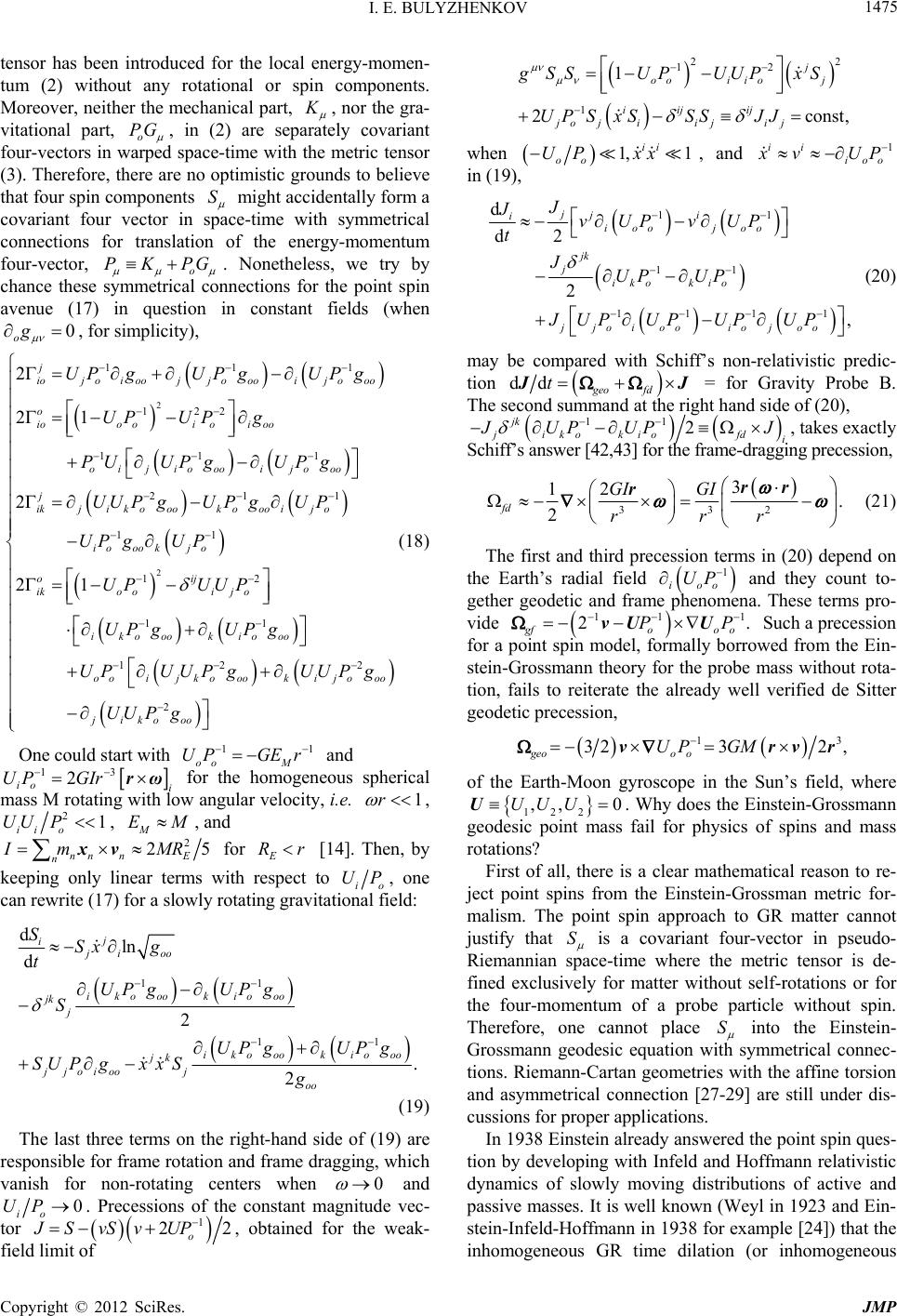 I. E. BULYZHENKOV 1475 tensor has been introduced for ergy-momen- tum (2) without an Moreover, neither the mechanical part, the local en y rotational or spin components. , nor the gra- vitational part, o PG , in (2) are separately covariant four-vectors in warped space-time with the metric tensor (3). Therefore, there are no optimistic grounds to believe that four spin components S might accidentally form a covariant four vector in space-time with symmetrical cof thennections for translatio energy-momentum four-vector, PKPG n o o l con k 12 k k o oo UPg oo UP . Nonetheless, we try by nections for the point spin avenue (17) in question in constant fields (when 0 og , for simplicity), 2 2 111 122 11 1 211 11 1 2 21 2 1 j ioj oijjoooij ooo o ioooioioo oi j ioooijooo j ikjooo ijo io ookjo j o oi UPgUP gUP g UPUP g PU UPgUPg UU PgU PgUP UP gUP UP UU (18) chance t 2 ik One h i U could start ese sym i k oo ji UP P UU metrica 2 2 ij ooo UUPg 11 M GE r and oo o oo oi j o P 11 2 ko ooiooo i jook ko gUPg U P g with 13 Ir ss M rotating with l 2G mio UP ai rω f o or th w a e homogeneous sphe ngular i.e. rrical 1 velocity, , 21, iio UUP M EM, and 2 25MR nn n Im keeping only n for E14]. Then, by linear terms to E xv Rr [ with respect io UP, one owly rotating gravitational field: can rewrite (17) for a sl 11 1 dln d . 2 ioo kiooo ooo jjo j SSx g t UPg g SU xxSg vanish fo-rotating cewhen 0 1 2 ik ooo jk j ikoooki jk oo UP g S UP gUP P j ji i g r non oo (19) The last three terms on the right-hand side of (19) are responsible for frame rotation and frame dragging, which nters and 0UPecessions of magnitude vec- tor io . Pr the constant 1 o JSv UP , obtained for the weak- field limit of 22 12 1 1 2const, j ooi ioj iijij jojii ji j gSSUPUUPxS UP SxSSSJJ when 22 vS 1, 1 ii oo UP xx , and iiioo 1 vUP in (19), 11 11 1 2 , jk jik o kio jjoioo iojoo JUP UP JUP UP UPUP 11 1 d d2 jji iioo joo J JvUP vUP t (20) mayf’s non-relativistic predic- tion be compared with Schif geo fd ddt J = for Gravity Probe B. The second summand at the right hand side of (20), 11 2 jk jikokio fd i UP UPJ , takes e Schiff’s answer [42,43] for the frame-dragging precession, xactly 332 12 . 2 GI rr r r r 3 fd GI r (21) The first and third precession terms in (20) depend on the Earth’s radial field 1 ioo UP and they count to- gether geodetic and frame phenomena. These terms pro- vide 11 1 2. gfoo o P vU U Such a prec for a point spin model, formally borrowed from the Ein- stein-Grossmann theory for the probe mass without rota- ession tion, fails to reiterate the already well verified de Sitter geodetic precession, 13 323 2 geoo o UP GM vrvr , of the Earth-Moon gyroscope in the Sun’s field, where 122 ,, 0UUU U. Why does the Einstein-Grossmann geodesic point mass fail for physics of spins and mass rotations? First of all, there is a clear mathematical reason to re- je roach t ct point spins from the Einstein-Grossman metric for- malism. The point spin appo GR matter cannot justify that S is a covariant four-vector in pseudo- Riemannian space-timetric tensor is de- fined exclusively for matter without self-rotations or for the four-momentum of a probe particle without spin. Therefore, one cannot place S e where the m into the Einstein- Grossmann geodesic equation with symmetrical connec- tions. Riemann-Cartan geometries with the affine torsion and asymmetrical connection [27-29] are still under dis- 19 e cussions for proper applications. In 38 Einstin already answered the point spin ques- tion by developing with Infeld and Hoffmann relativistic dynamics of slowly moving distributions of active and passive masses. It is well known (Weyl in 1923 and Ein- stein-Infeld-Hoffmann in 1938 for example [24]) that the inhomogeneous GR time dilation (or inhomogeneous Copyright © 2012 SciRes. JMP 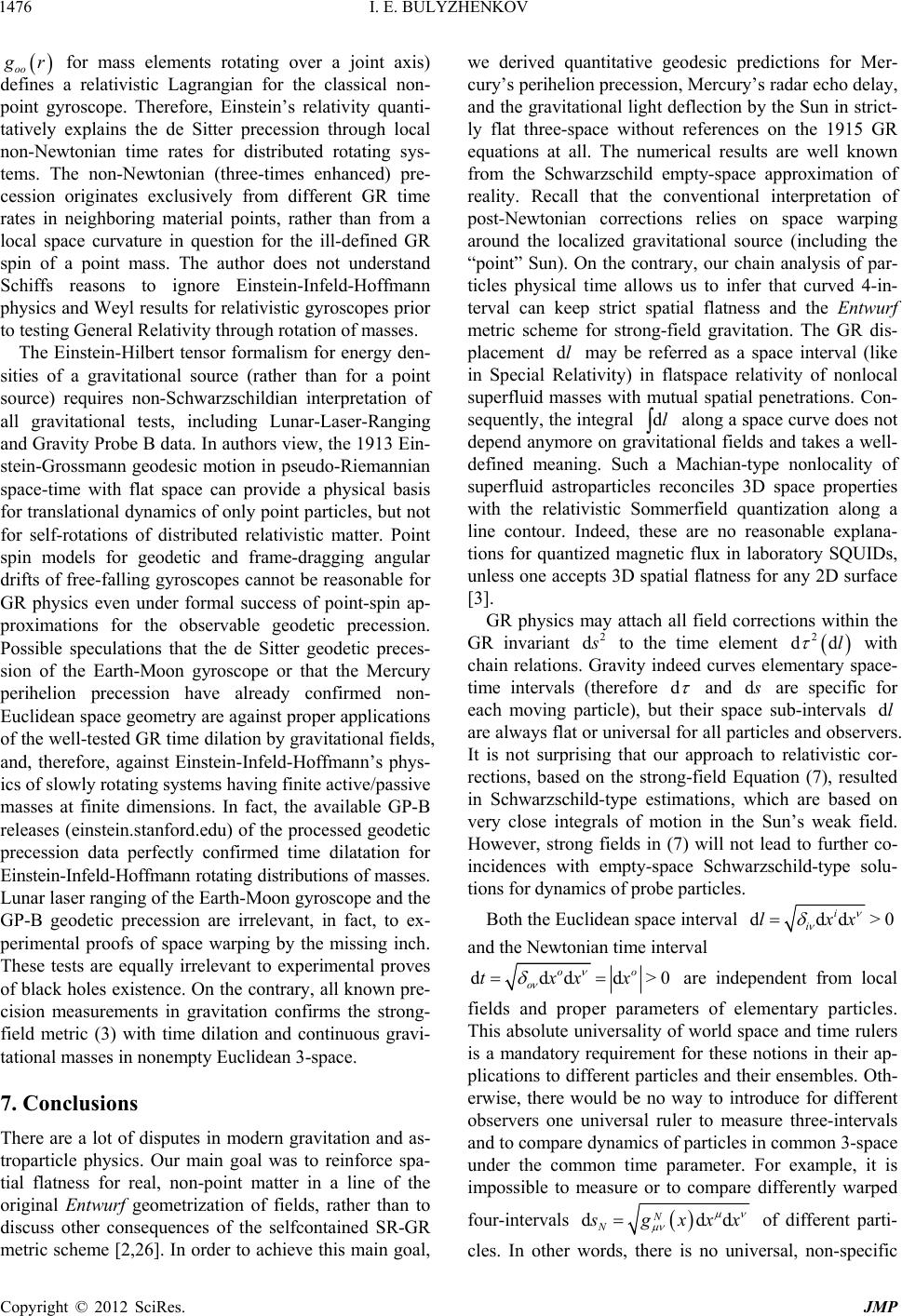 I. E. BULYZHENKOV 1476 oo r for mass elements rotating over a joint axis) defines a relvistic Lagrangian for the classical non- point gyroscope. Therefore, Einstein’s relativity quanti- tatively explains the de Sitter precession through local non-Newtonian time rates for distributed rotating sys- tems. The non-Newtonian (three-times enhanced) pre- cession originates exclusively from different GR time rates in neighboring material points, rather than from a local space curvature in question for the ill-defined GR spin of a point mass. The autho ati r does not understand Sc all gra Eu metric scheme [2,26]. In order to achieve this main goal, warping around the localized gravitational source (including the e contrary, our chain analysis of par- allows us to infer that curved 4-in- hiffs reasons to ignore Einstein-Infeld-Hoffmann physics and Weyl results for relativistic gyroscopes prior to testing General Relativity through rotation of masses. The Einstein-Hilbert tensor formalism for energy den- sities of a gravitational source (rather than for a point source) requires non-Schwarzschildian interpretation of vitational tests, including Lunar-Laser-Ranging and Gravity Probe B data. In authors view, the 1913 Ein- stein-Grossmann geodesic motion in pseudo-Riemannian space-time with flat space can provide a physical basis for translational dynamics of only point particles, but not for self-rotations of distributed relativistic matter. Point spin models for geodetic and frame-dragging angular drifts of free-falling gyroscopes cannot be reasonable for GR physics even under formal success of point-spin ap- proximations for the observable geodetic precession. Possible speculations that the de Sitter geodetic preces- sion of the Earth-Moon gyroscope or that the Mercury perihelion precession have already confirmed non- clidean space geometry are against proper applications of the well-tested GR time dilation by gravitational fields, and, therefore, against Einstein-Infeld-Hoffmann’s phys- ics of slowly rotating systems having finite active/passive masses at finite dimensions. In fact, the available GP-B releases (einstein.stanford.edu) of the processed geodetic precession data perfectly confirmed time dilatation for Einstein-Infeld-Hoffmann rotating distributions of masses. Lunar laser ranging of the Earth-Moon gyroscope and the GP-B geodetic precession are irrelevant, in fact, to ex- perimental proofs of space warping by the missing inch. These tests are equally irrelevant to experimental proves of black holes existence. On the contrary, all known pre- cision measurements in gravitation confirms the strong- field metric (3) with time dilation and continuous gravi- tational masses in nonempty Euclidean 3-space. 7. Conclusions There are a lot of disputes in modern gravitation and as- troparticle physics. Our main goal was to reinforce spa- tial flatness for real, non-point matter in a line of the original En twur f geometrization of fields, rather than to discuss other consequences of the selfcontained SR-GR we derived quantitative geodesic predictions for Mer- cury’s perihelion precession, Mercury’s radar echo delay, and the gravitational light deflection by the Sun in strict- ly flat three-space without references on the 1915 GR equations at all. The numerical results are well known from the Schwarzschild empty-space approximation of reality. Recall that the conventional interpretation of post-Newtonian corrections relies on space “point” Sun). On th ticles physical time terval can keep strict spatial flatness and the Entwurf metric scheme for strong-field gravitation. The GR dis- placement dl may be referred as a space interval (like in Special Relativity) in flatspace relativity of nonlocal superfluid masses with mutual spatial penetrations. Con- sequently, the integral dl along a space curve does not depend anymore on gravitational fields and takes a well- defined meaning. Such a Machian-type nonlocality of superfluid astroparticles reconciles 3D space properties with the relativistic Sommerfield quantization along a line contour. Indeed, these are no reasonable explana- tions for quantized magnetic flux in laboratory SQUIDs, unless one accepts 3D spatial flatness for any 2D surface [3]. GR physics may attach all field corrections within the GR invariant 2 d to the time element 2 ddl with chain relations. Gravity indeed curves elementary space- time intervals (therefore d and d are specific for each moving particle), but their space sub-intervals dl are always flat or universal for all particles and observers. It is not surprising that our approach to relativistic cor- rections, based on the strong-field Equation (7), resulted in Schwarzschild-type estimations, which are based on very close integrals of motion in the Sun’s weak field. However, strong fields in (7) will not lead to further co- incidences with empty-space Schwarzschild-type solu- tions for dynamics of probe particles. Both the Euclidean space interval ddd>0 i i lxx and the Newtonian time interval dtddd>0 oo xxx are independent from local ery par n o fields and prop parameters of elementarticles. This absolute universality of world space and time rulers is a mandatory requirement for these otions in their ap- plications to different particles and their ensembles. Oth- erwise, there would be no way to introduce for different observers one universal ruler to measure three-intervals and to compare dynamics of particles in common 3-space under the common time parameter. For example, it is impossible to measure or to compare differently warped four-intervals ddd N N gxxx of different parti- cles. In other words, there is no universal, non-specific Copyright © 2012 SciRes. JMP 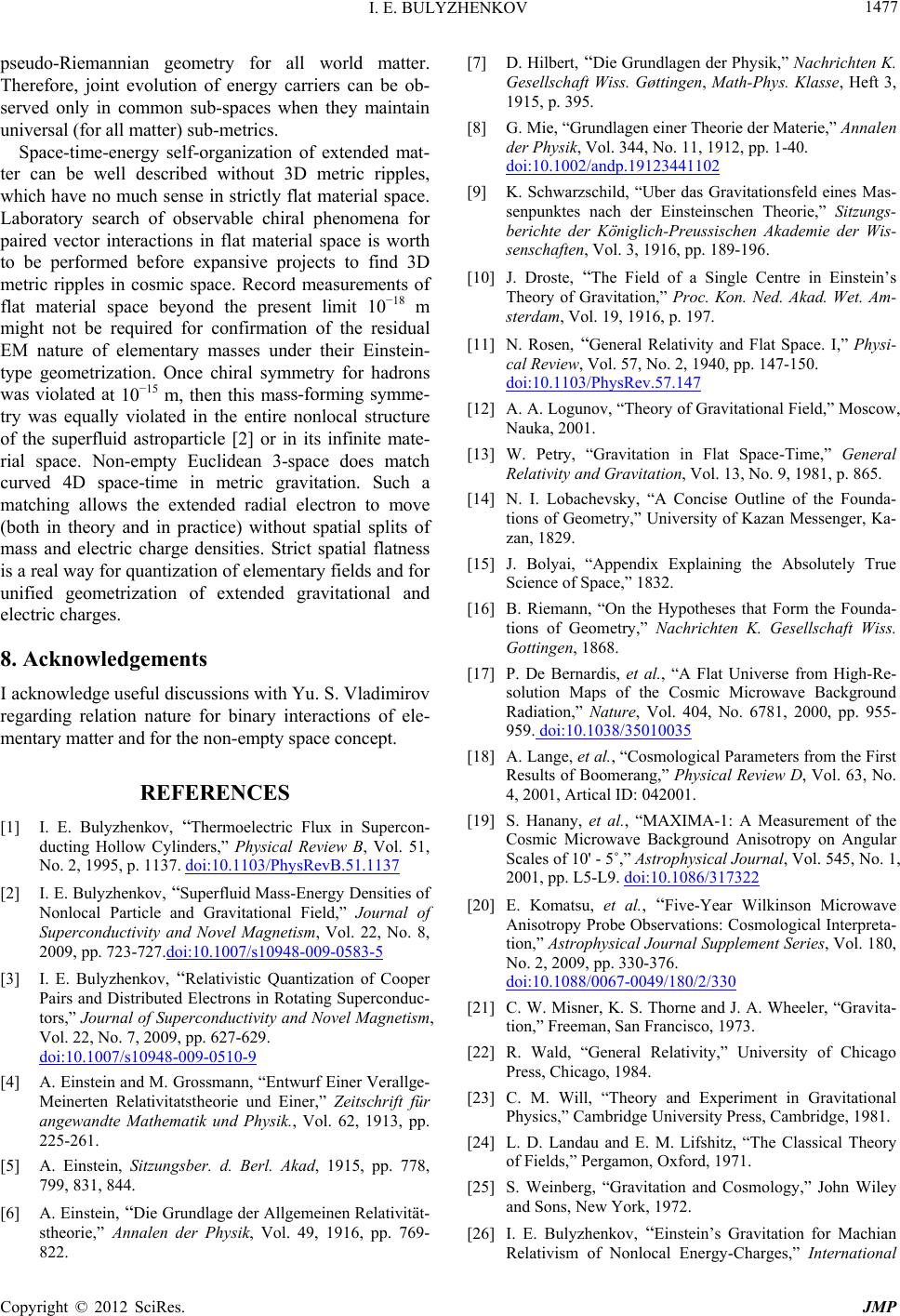 I. E. BULYZHENKOV 1477 pseudo-Riemannian geometry for all world m Th carriers can be ob- when they maintain cs. Space-time-energy self-o t 10−15 m, then this ma atter. erefore, joint evolution of energy served only in common sub-spaces universal (for all matter) sub-metri rganization of extended mat- ter can be well described without 3D metric ripples, which have no much sense in strictly flat material space. Laboratory search of observable chiral phenomena for paired vector interactions in flat material space is worth to be performed before expansive projects to find 3D metric ripples in cosmic space. Record measurements of flat material space beyond the present limit 10−18 m might not be required for confirmation of the residual EM nature of elementary masses under their Einstein- type geometrization. Once chiral symmetry for hadrons was violated ass-forming symme- try was equally violated in the entire nonlocal structure of the superfluid astroparticle [2] or in its infinite mate- rial space. Non-empty Euclidean 3-space does match curved 4D space-time in metric gravitation. Such a matching allows the extended radial electron to move (both in theory and in practice) without spatial splits of mass and electric charge densities. Strict spatial flatness is a real way for quantization of elementary fields and for unified geometrization of extended gravitational and electric charges. 8. Acknowledgements I acknowledge useful discussions with Yu. S. Vladimirov regarding relation nature for binary interactions of ele- mentary matter and for the non-empty space concept. REFERENCES [1] I. E. Bulyzhenkov, “Thermoelectric Flux in Supercon- ducting Hollow Cylinders,” Physical Review B, Vol. 51, No. 2, 1995, p. 1137. doi:10.1103/PhysRevB.51.1137 [2] I. E. Bulyzhenkov, “Superfluid Mass-Energy Densities of Nonlocal Particle and Gravitational Field,” Journal of Superconductivity and Novel Magnetism, Vol. 22, No. 8, 2009, pp. 723-727.doi:10.1007/s10948-009-0583-5 [3] I. E. Bulyzhenkov, “Relativistic Quantization of Cooper Pairs and Distributed Electrons in Rotating Superconduc- tors,” Journal of Superconductivity and Novel Magnetism 27-629. 510-9 , Vol. 22, No. 7, 2009, pp. 6 doi:10.1007/s10948-009-0 pp 225-261. [5] A. Einstein, S ad, 1915, pp. 778 799, 831, 844. nalen [4] A. Einstein and M. Grossmann, “Entwurf Einer Verallge- Meinerten Relativitatstheorie und Einer,” Zeitschrift für angewandte Mathematik und Physik., Vol. 62, 1913, . itzungsber. d. Berl. Ak, [6] A. Einstein, “Die Grundlage der Allgemeinen Relativität- stheorie,” Annalen der Physik, Vol. 49, 1916, pp. 769- 822. [7] D. Hilbert, “Die Grundlagen der Physik,” Nachrichten K. Gesellschaft Wiss. Gøttingen, Math-Phys. Klasse, Heft 3, 1915, p. 395. [8] G. Mie, “Grundlagen einer Theorie der Materie,” An der Physik, Vol. 344, No. 11, 1912, pp. 1-40. doi:10.1002/andp.19123441102 [9] K. Schwarzschild, “Uber das Gravitationsfeld eines Mas- senpunktes nach der Einsteinsche berichte der Königlich-Preussisc n Theorie,” Sitzungs- hen Akademie der Wis- ol. 19, 1916, p. 197. . 57, No. 2, 1940, pp. 147-150. senschaften, Vol. 3, 1916, pp. 189-196. [10] J. Droste, “The Field of a Single Centre in Einstein’s Theory of Gravitation,” Proc. Kon. Ned. Akad. Wet. Am- sterdam, V [11] N. Rosen, “General Relativity and Flat Space. I,” Physi- cal Review, Vol doi:10.1103/PhysRev.57.147 [12] A. A. Logunov, “Theory of Gravitational Field,” Moscow, Nauka, 2001. , pp. 955- [13] W. Petry, “Gravitation in Flat Space-Time,” General Relativity and Gravitation, Vol. 13, No. 9, 1981, p. 865. N. I. Lobache[14] vsky, “A Concise Outline of the Founda- tions of Geometry,” University of Kazan Messenger, Ka- zan, 1829. J. Bolyai, “Appendix Explainin[15] g the Absolutely True Science of Space,” 1832. [16] B. Riemann, “On the Hypotheses that Form the Founda- tions of Geometry,” Nachrichten K. Gesellschaft Wiss. Gottingen, 1868. [17] P. De Bernardis, et al., “A Flat Universe from High-Re- solution Maps of the Cosmic Microwave Background Radiation,” Nature, Vol. 404, No. 6781, 2000 959. doi:10.1038/35010035 [18] A. Lange, et al., “Cosmological Parameters from Results of Boomerang,” Physic the First al Review D, Vol. 63, No. l., “MAXIMA-1: A Measurement of the , 4, 2001, Artical ID: 042001. [19] S. Hanany, et a Cosmic Microwave Background Anisotropy on Angular Scales of 10' - 5˚,” Astrophysical Journal, Vol. 545, No. 1 2001, pp. L5-L9. doi:10.1086/317322 [20] E. Komatsu, et al., “Five-Year Wilkinson Microwave Anisotropy Probe Observations: Cosmological Interpreta- tion,” Astrophysical Journal Supplement Series, Vol. 180, No. 2, 2009, pp. 330-376. doi:10.1088/0067-0049/180/2/330 [21] C. W. Misner, K. S. Thorne and J. A. Wheeler, “Gravita- tion,” Freeman, San Francisco, 1973. [22] R. Wald, “General Relativity,” University of Chicago Press, Chicago, 1984. [23] C. M. Will, “Theory and Experiment in Gravitational Physics,” Cambridge University Press, Cambridge, 1981. d Cosmology,” John Wiley [24] L. D. Landau and E. M. Lifshitz, “The Classical Theory of Fields,” Pergamon, Oxford, 1971. [25] S. Weinberg, “Gravitation an and Sons, New York, 1972. [26] I. E. Bulyzhenkov, “Einstein’s Gravitation for Machian Relativism of Nonlocal Energy-Charges,” International Copyright © 2012 SciRes. JMP 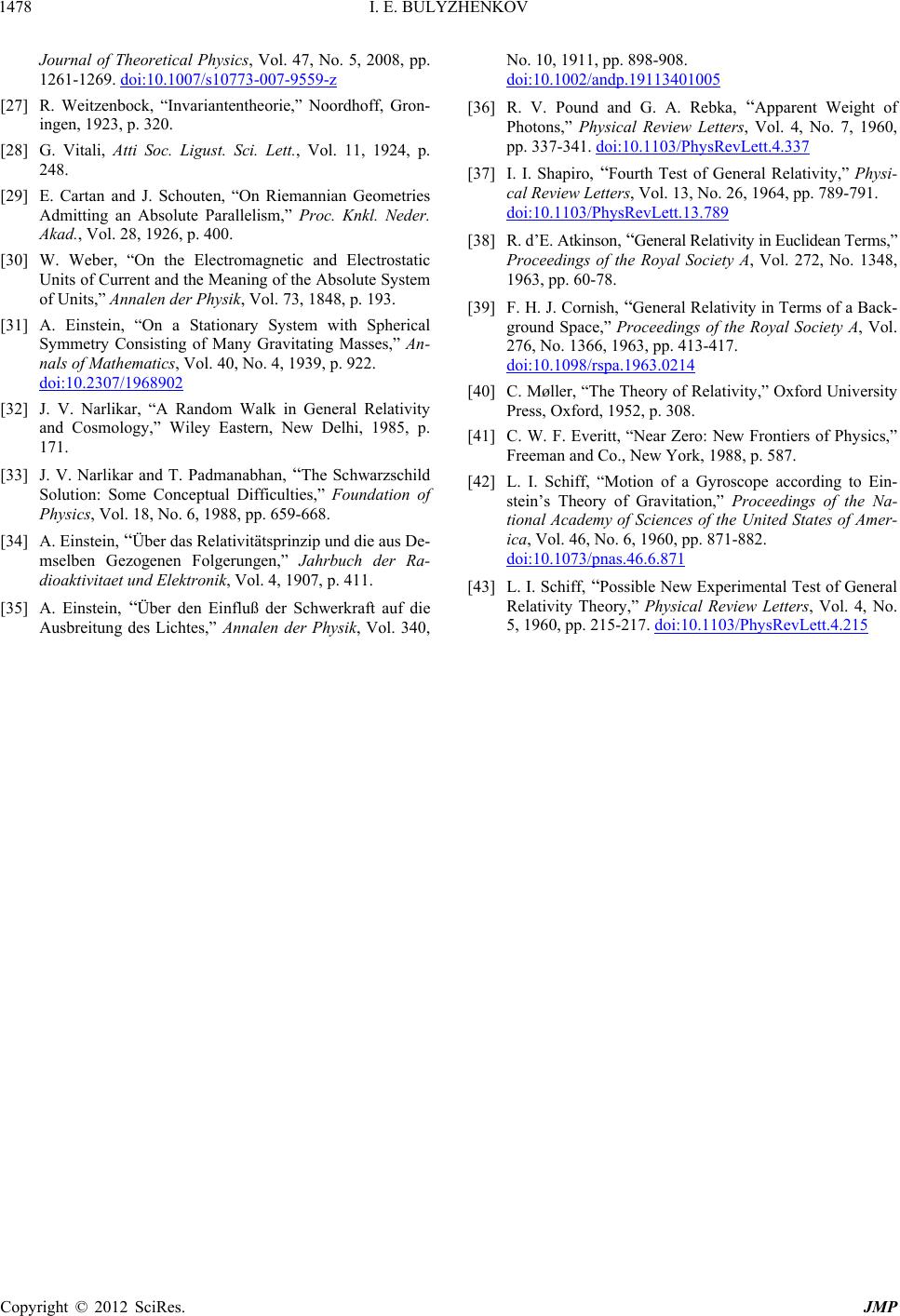 I. E. BULYZHENKOV Copyright © 2012 SciRes. JMP 1478 7, No. 5, 2008, pp.Journal of Theoretical Physics, Vol. 4 1261-1269. doi:10.1007/s10773-007-9559-z [27] R. Weitzenbock, “Invariantentheorie,” Noordhoff, Gron- ingen, 1923, p. 320. [28] G. Vitali, Atti Soc. Ligust. Sci. Lett. 248. , Vol. 11, 1924, p Proc. Knkl. N Electromagnetic and Electrostatic tating Masses,” An- . [29] E. Cartan and J. Schouten, “On Riemannian Geometries Admitting an Absolute Parallelism,” eder. Akad., Vol. 28, 1926, p. 400. [30] W. Weber, “On the Units of Current and the Meaning of the Absolute System of Units,” Annalen der Physik, Vol. 73, 1848, p. 193. [31] A. Einstein, “On a Stationary System with Spherical Symmetry Consisting of Many Gravi nals of Mathematics, Vol. 40, No. 4, 1939, p. 922. doi:10.2307/1968902 [32] J. V. Narlikar, “A Random Walk in General Relativity and Cosmology,” Wiley Eastern, New Delhi, 1985, p. 171. [33] J. V. Narlikar and T. Padmanabhan, “The Schwarzschild nalen der Physik, Vol. 0, 1911, pp. 898-908. Solution: Some Conceptual Difficulties,” Foundation of Physics, Vol. 18, No. 6, 1988, pp. 659-668. [34] A. Einstein, “Über das Relativitätsprinzip und die aus De- mselben Gezogenen Folgerungen,” Jahrbuch der Ra- dioaktivitaet und Elektronik, Vol. 4, 1907, p. 411. [35] A. Einstein, “Über den Einfluß der Schwerkraft auf die Ausbreitung des Lichtes,” An 340, No. 1 doi:10.1002/andp.19113401005 [36] R. V. Pound and G. A. Rebka, “Apparent Weight of Photons,” Physical Review Letters, Vol. 4, No. 7, 1960, pp. 337-341. doi:10.1103/PhysRevLett.4.337 [37] I. I. Shapiro, “Fourth Test of General Relativity,” Physi- cal Review Letters, Vol. 13, No. 26, 1964, pp. 789-791. doi:10.1103/PhysRevLett.13.789 [38] R. d’E. Atkinson, “General Relativity in Euclidean Terms,” Proceedings of the Royal Soc 1963, pp. 60-78. iety A, Vol. 272, No. 1348, [39] F. H. J. Cornish, “General Relativity in Terms of a Back- ground Space,” Proceedings of the Royal Society A, Vol. 276, No. 1366, 1963, pp. 413-417. doi:10.1098/rspa.1963.0214 [40] C. Møller, “The Theory of Relativity,” Oxford University Press, Oxford, 1952, p. 308. tion of a Gyroscope according to Ein- [41] C. W. F. Everitt, “Near Zero: New Frontiers of Physics,” Freeman and Co., New York, 1988, p. 587. [42] L. I. Schiff, “Mo stein’s Theory of Gravitation,” Proceedings of the Na- tional Academy of Sciences of the United States of Amer- ica, Vol. 46, No. 6, 1960, pp. 871-882. doi:10.1073/pnas.46.6.871 [43] L. I. Schiff, “Possible New Experimental Test of General Relativity Theory,” Physical Review Letters, Vol. 4, No. 5, 1960, pp. 215-217. doi:10.1103/PhysRevLett.4.215
|